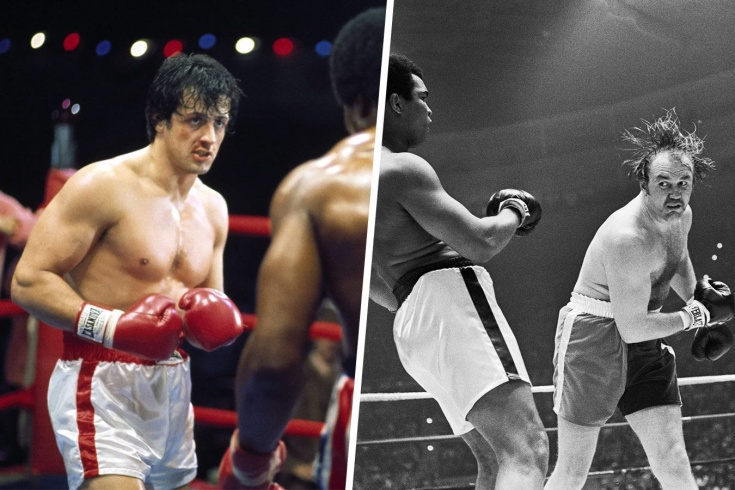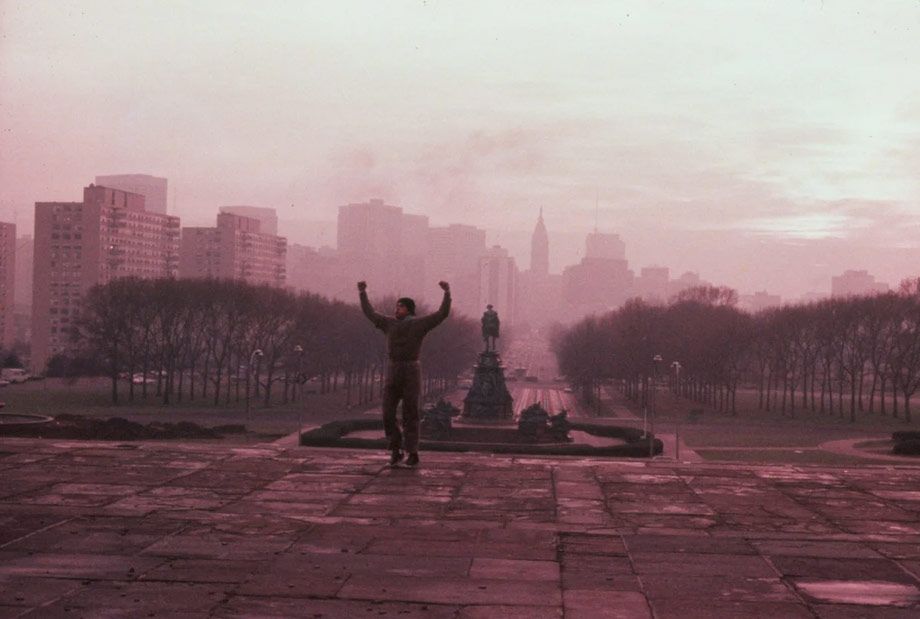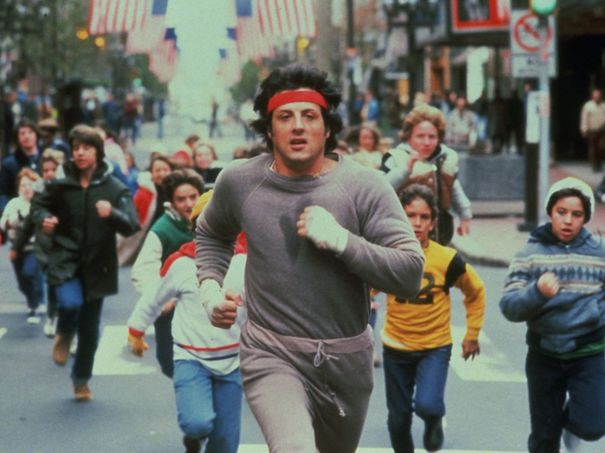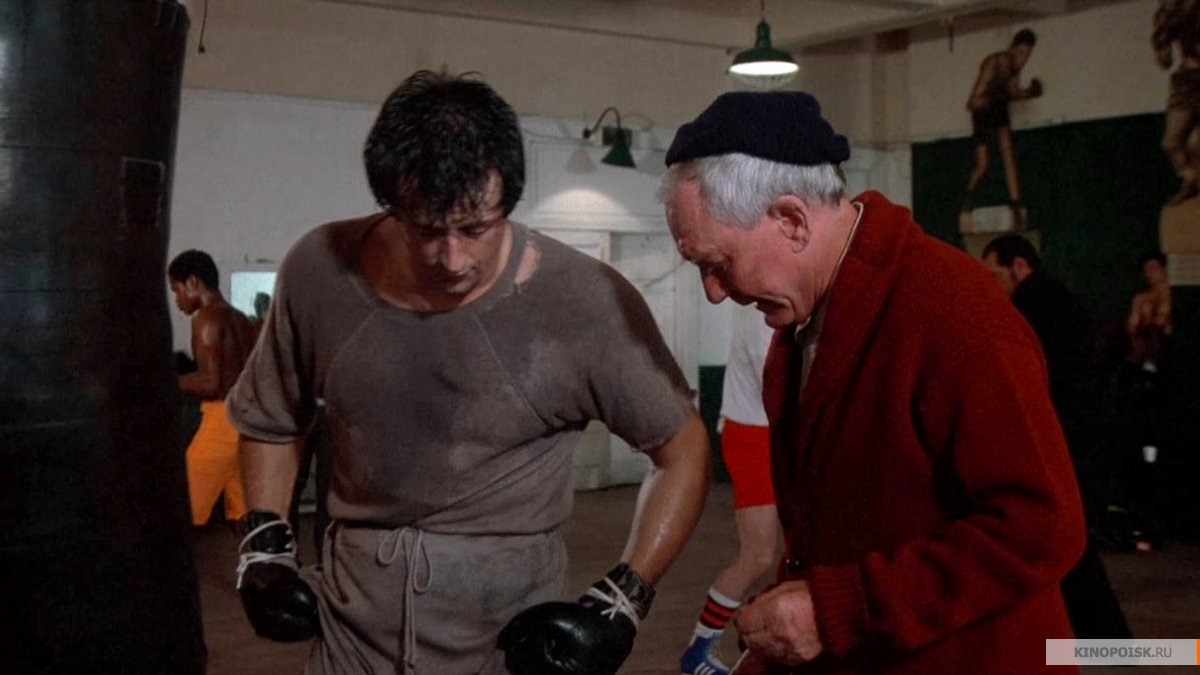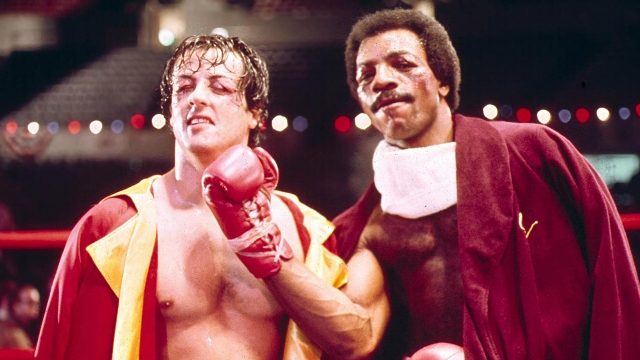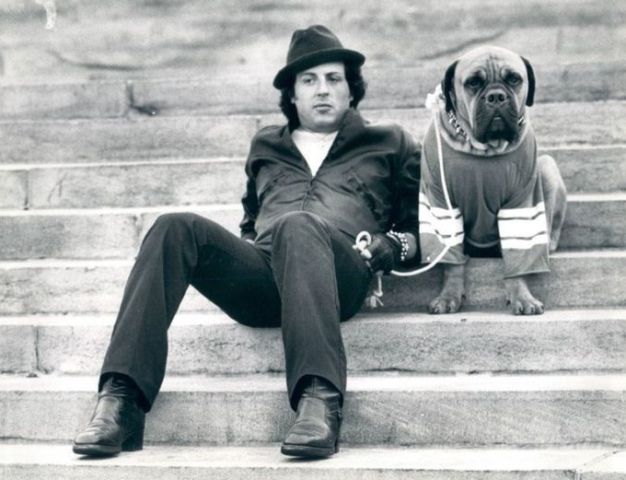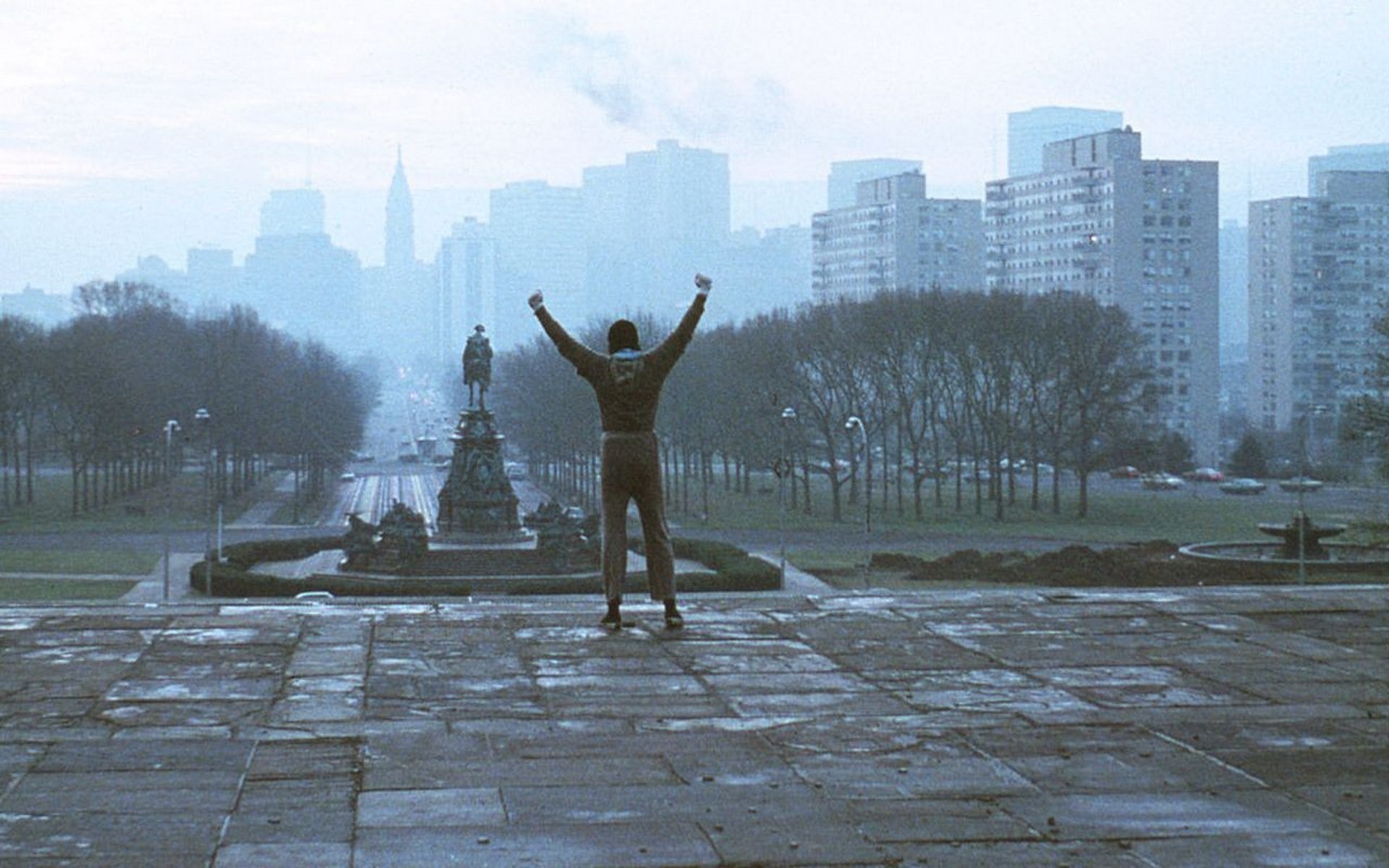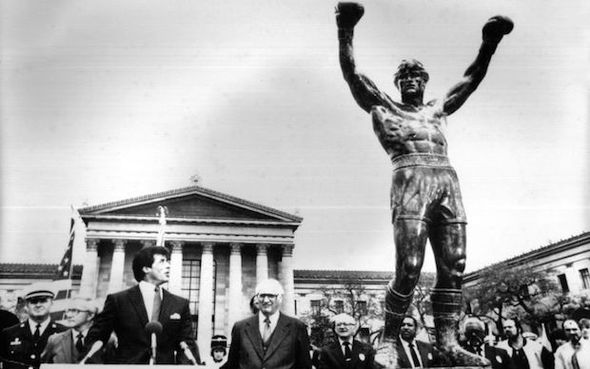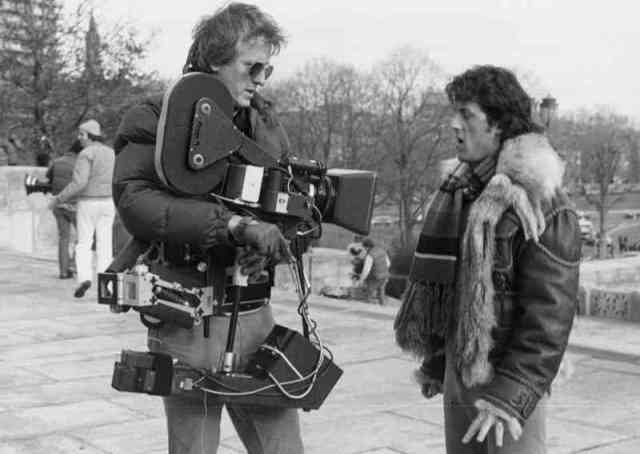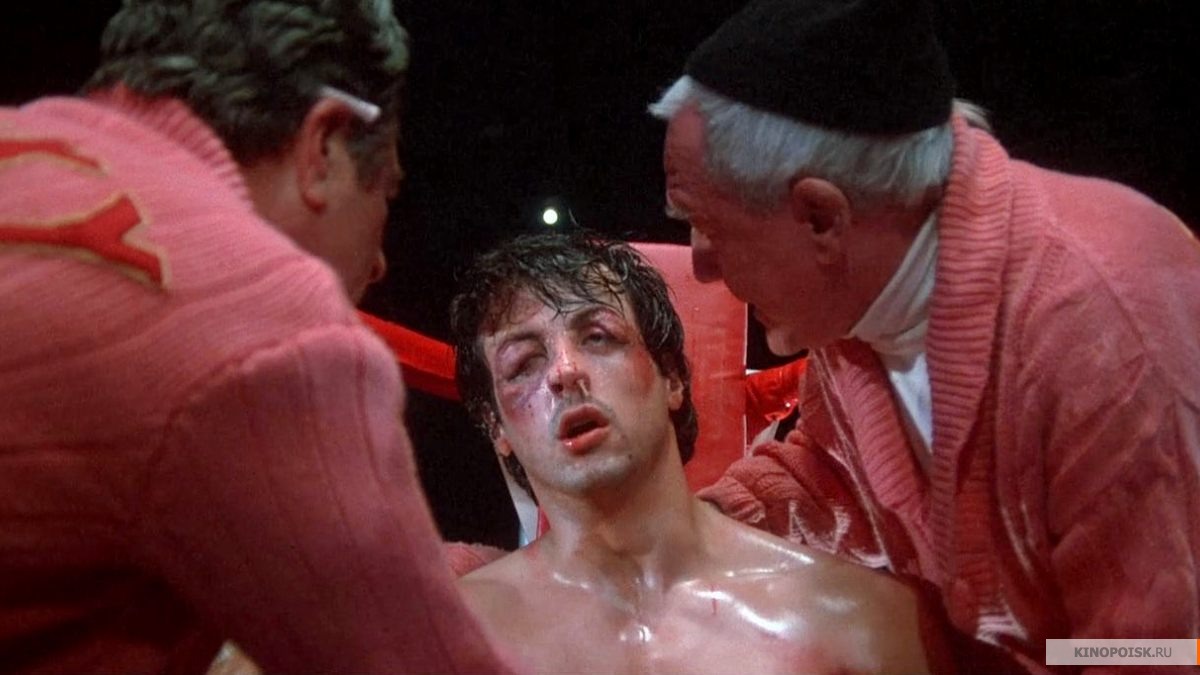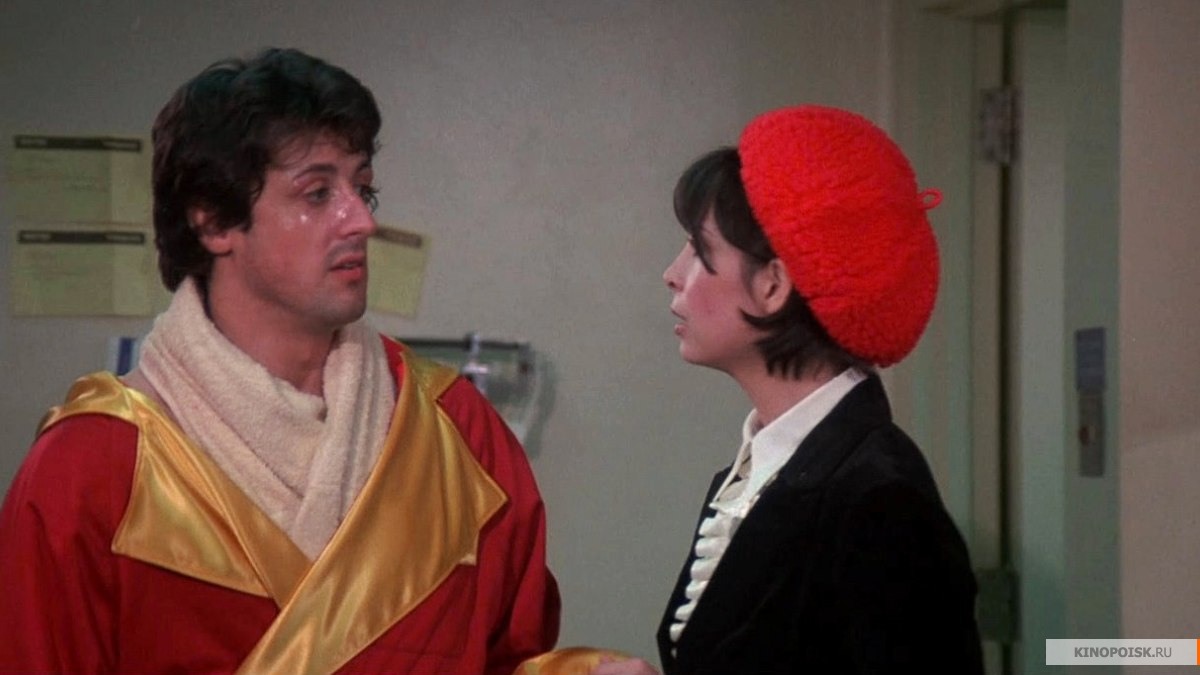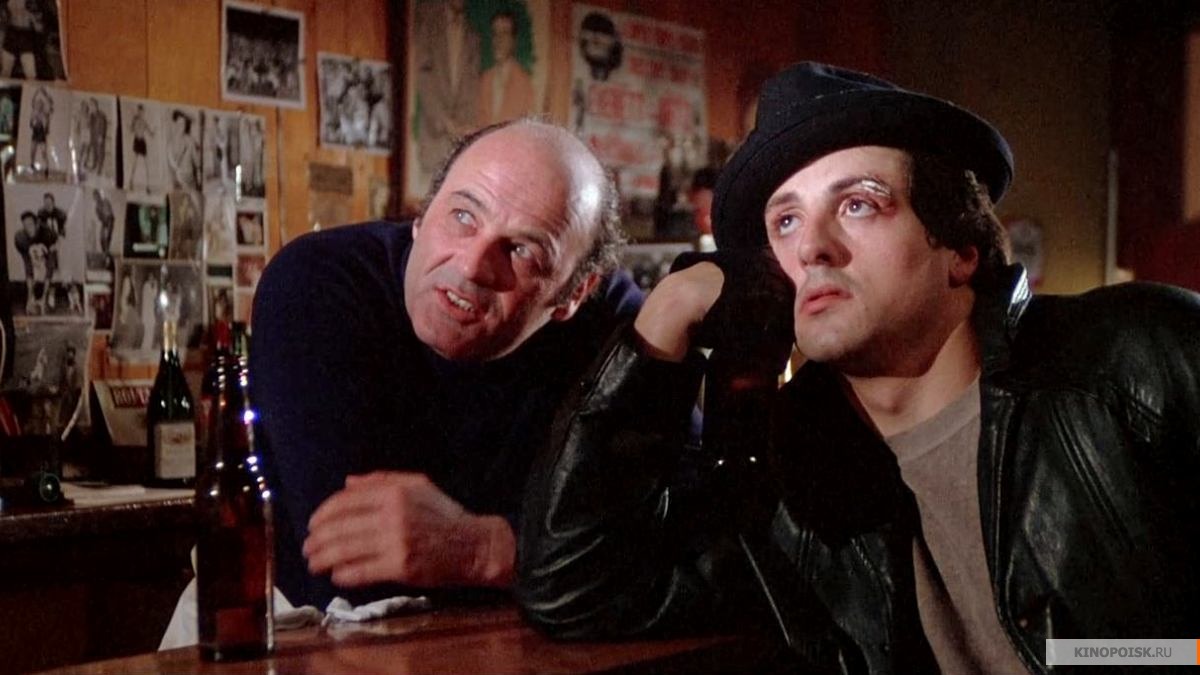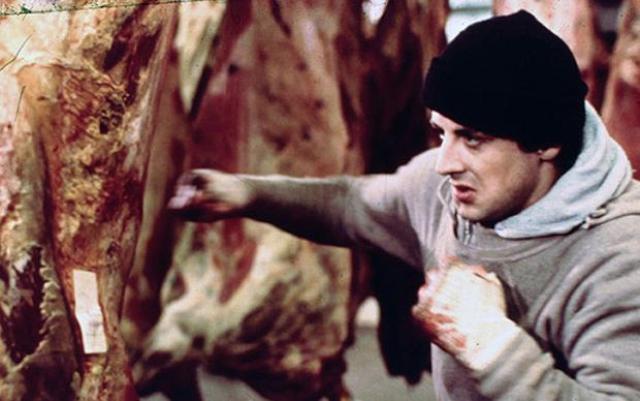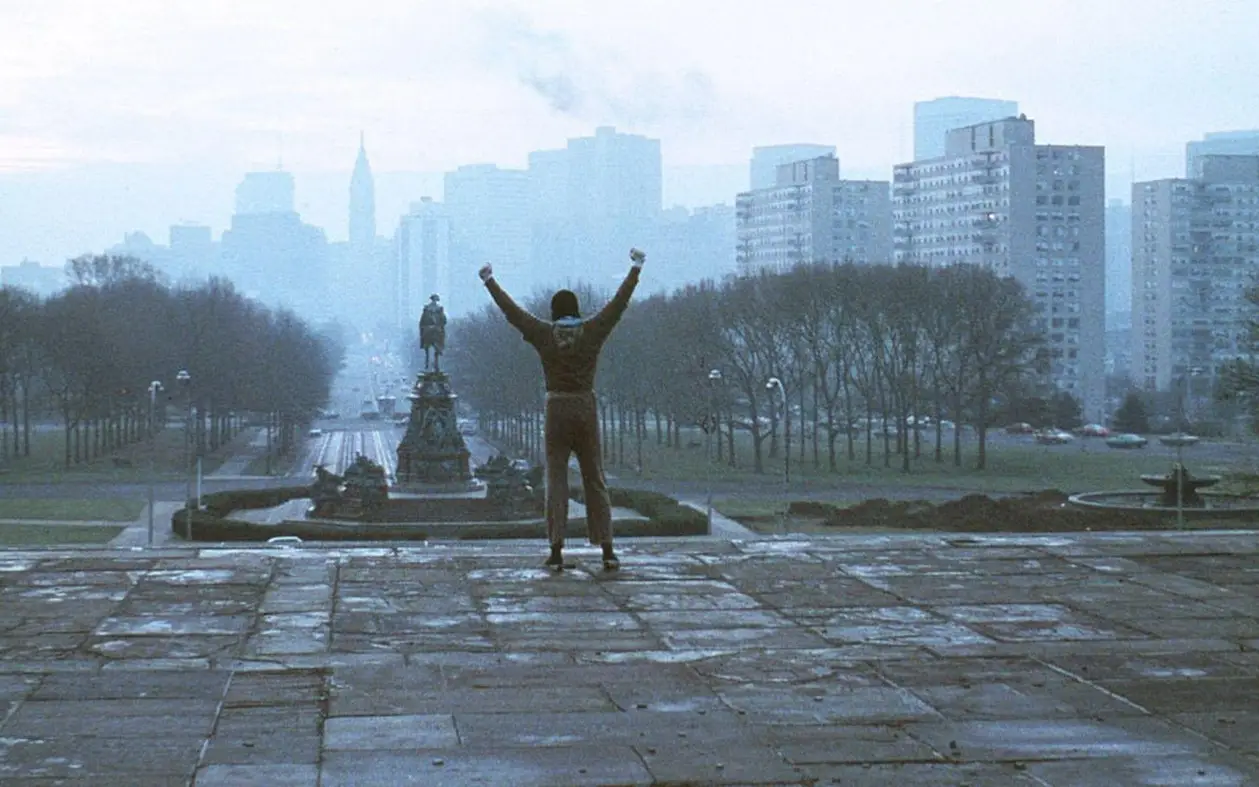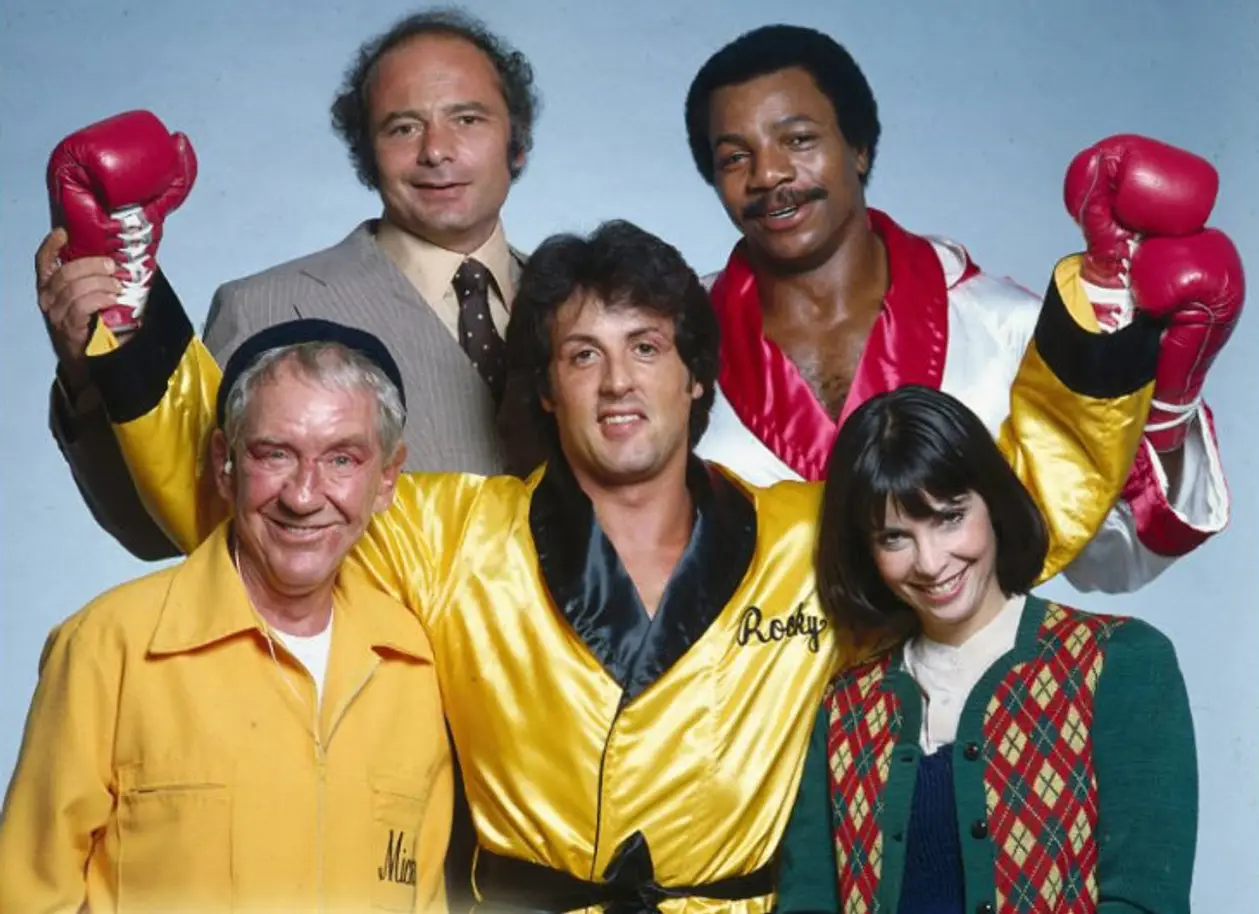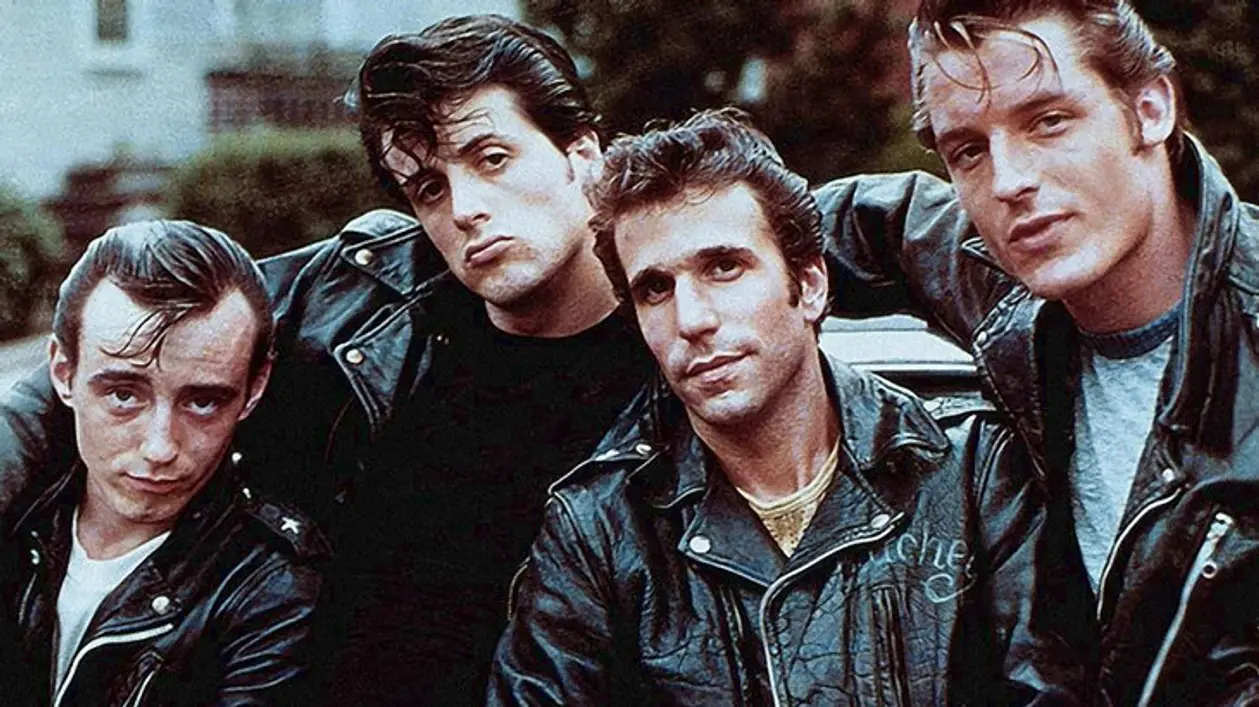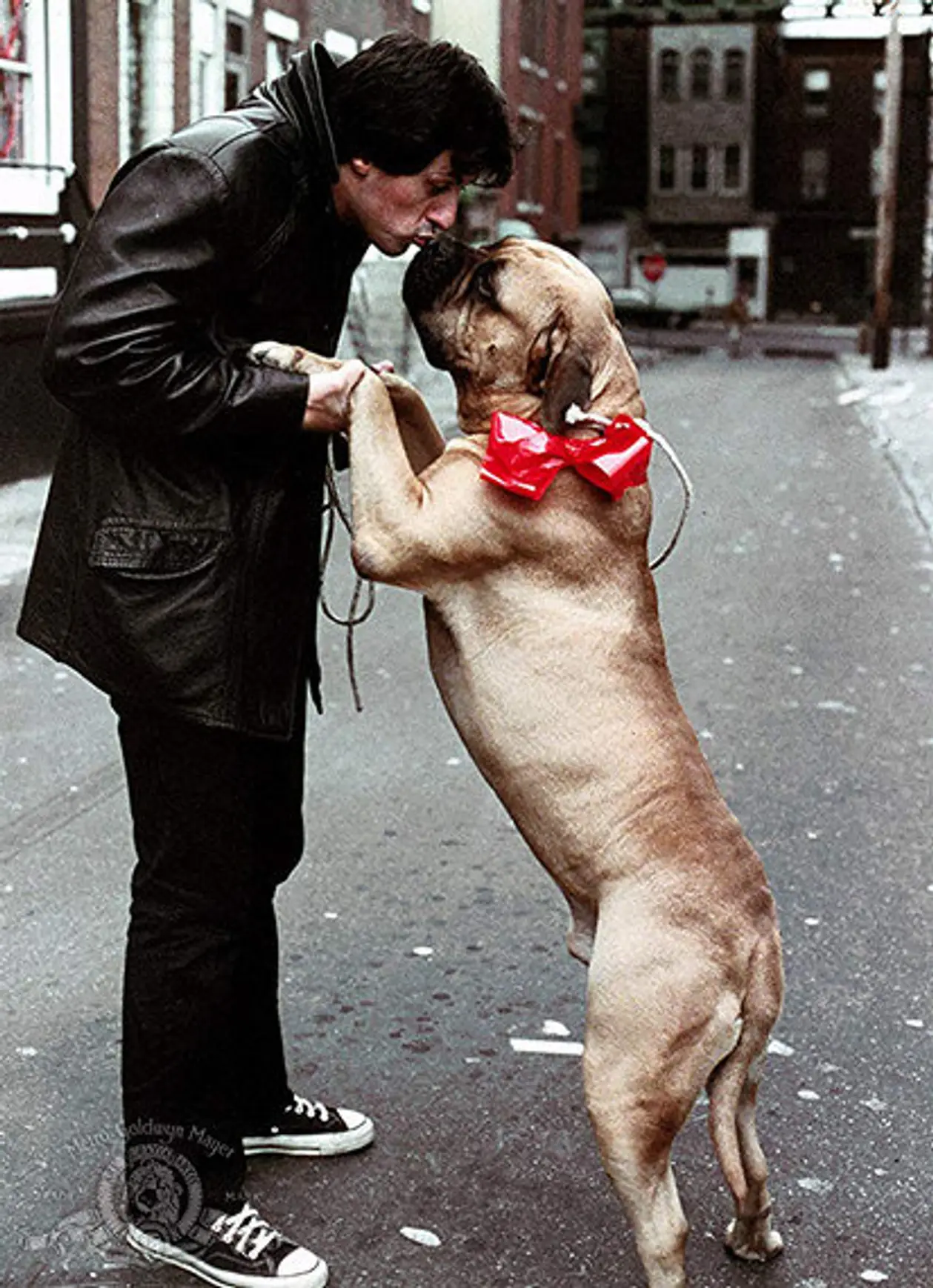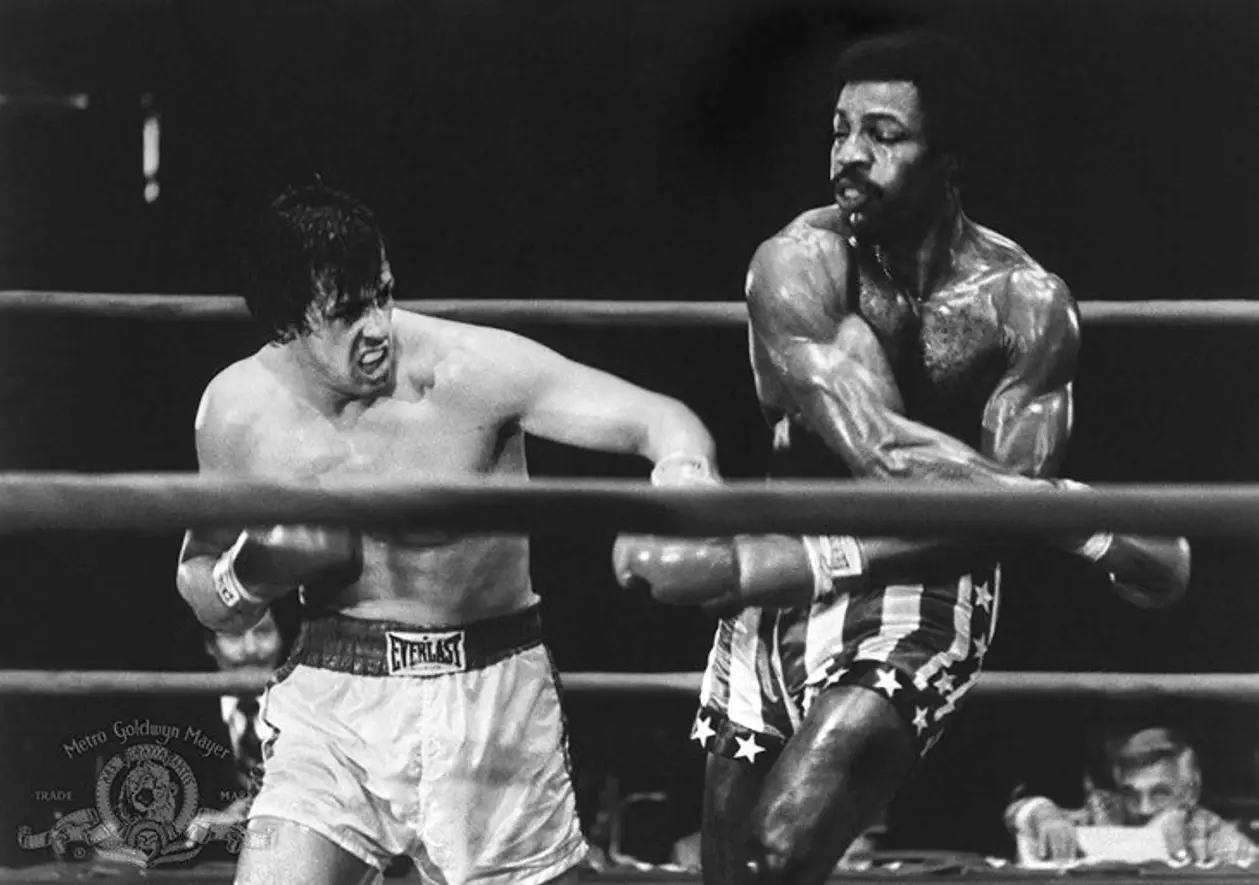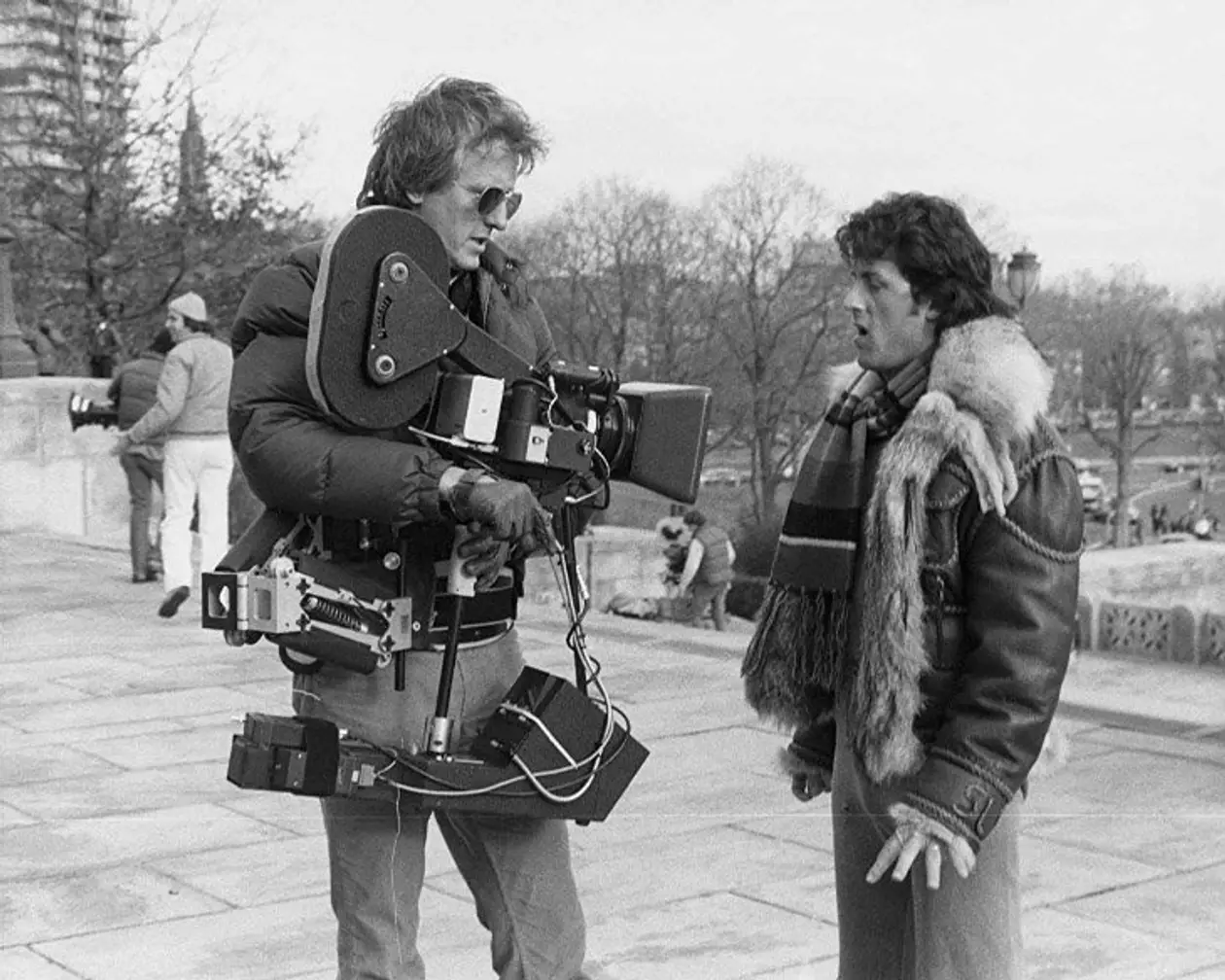Сильвестр Сталлоне давно стал символом боевиков и культовой фигурой в мире кино. КиноПоиск празднует 70-летие Слая и вспоминает один из его самых знаковых фильмов — «Рокки», который получил три премии «Оскар».
Актер, режиссер, сценарист, продюсер и культовая фигура мира кино — Сильвестр Сталлоне давно стал символом боевиков и ролевой моделью для множества поклонников. КиноПоиск празднует 70-летие Слая и вспоминает один из его самых знаковых фильмов — «Рокки», который получил три премии «Оскар».
1. Сценарий «Рокки» Сильвестр Сталлоне написал собственноручно за три с половиной дня. В 1975 году актеру исполнилось 29, и в день рождения у него в кармане было всего 106 долларов. Он жил в затрапезной квартире в Лос-Анджелесе, жена Саша была беременна, а бульмастиф Баткис, которого впоследствии Слай возьмет в два фильма, голодал.
2. Чтобы свести концы с концами, Сталлоне даже продал Баткиса семье, где его могли прокормить. Спустя полгода актер вернулся за псом и уговорил новых владельцев отдать его на съемки.
3. В титрах пес именуется Баткис Сталлоне. Но свое имя бульмастиф получил в честь Дика Баткиса, одного из самых свирепых футболистов в истории. На момент начала съемок собаке было шесть лет.
4. За сценарий Сильвестр Сталлоне взялся потому, что разочаровался в поисках нормальных ролей. К тридцати годам он сыграл в провалившейся мелодраме «Лорды Флэтбуша», в драме «Капоне» и в боевике «Смертельные гонки 2000 года».
5. Мать Сталлоне, увлекающаяся астрологией, предсказала сыну, что своего первого успеха он добьется на сценарном поприще.
6. До того как Сильвестру в голову пришла идея «Рокки», он успел продать несколько сценариев для телевидения.
7. Известно, что вдохновением для «Рокки» послужил бой Мухаммеда Али и никому не известного боксера Чака Уэпнера. Но мало кто знает, что Сталлоне смотрел этот матч в кинотеатре.
8. Слай думал о фильме месяц, потом 10 месяцев вынашивал идею. И в один прекрасный день, проснувшись в шесть утра, Сталлоне взял ручку, бумагу и принялся за текст. Затем его жена перепечатала сценарий на машинке.
9. У «Рокки» было три варианта сценария. В первом Сталлоне наметил скелет сюжета, а затем начал навешивать на него мясцо в виде диалогов, юмора и особенностей героев.
10. Голливуд очень хотел видеть звезду в главной роли, но Сталлоне был категорически против, поскольку написал текст для себя. Он говорил жене: «Лучше я закопаю сценарий у нас в саду, и пусть гусеницы играют „Рокки“».
11. Когда в 1970-х Сильвестр Сталлоне рассказывал, что «Рокки» был снят за 28 дней, он добавлял, что это время созревания личинки водяного клопа.
12. Сильвестр Сталлоне никогда не занимался боксом профессионально. До начала съемок «Рокки» он начал тренироваться по шесть дней в неделю и провел пять месяцев в изнурительной подготовке. Он вставал на рассвете, пробегал восемь километров по берегу, боксировал и отправлялся в тренажерный зал. В его ежедневное питание входило 113 таблеток витаминов.
13. Когда Сталлоне впервые вышел на съемочную площадку «Рокки», его спросили, готов ли он. «Я — нет, но Рокки готов», — ответил актер.
14. Хореографией финального боя заведовал режиссер Джон Г. Эвилдсен. Он расписал каждый удар. По словам Сталлоне, в сценарии оказалось 14 страниц текста со словами «хук справа» и «хук слева».
15. Серая поношенная толстовка, в которой мы видим Рокки в финале, дожила до наших дней. Она находится в личной коллекции Сильвестра Сталлоне. Актер пообещал передать ее Смитсоновскому музею.
16. Жители Филадельфии всегда посмеиваются, когда смотрят на сцену пробежки Рокки мимо достопримечательностей. В реальности Рокки никак бы не смог преодолеть 32 километра за несколько минут.
17. Талия Шайр, игравшая Эдриан, возлюбленную Рокки, во время съемок сцены первого поцелуя со Сталлоне была больна гриппом. Она боялась заразить актера и уклонялась от него. Сцена получилась отлично, но Слай в итоге подхватил грипп и снимал следующую сцену (тренировку в зале Микки) с температурой.
18. Несмотря на то, что во время выхода фильма многие считали, что Сталлоне — поклонник актеров вроде Марлона Брандо и Аль Пачино, сам он признавался, что его кумир — Питер О’Тул. «Брандо и Пачино очень серьезные. Я их уважаю, но люблю Питера О’Тула. Он очень раскованный. Кажется, он может ухлестывать за статисткой на площадке, но, когда включаются камеры, в нем моментально включается актерская мощь».
19. Сталлоне сравнивал себя с Рокки. В интервью The New York Times в 1976 году актер говорил: «После выхода фильма знакомые, которые долгие годы не говорили мне ничего хорошего, начали подходить ко мне и говорить: „Мужик, ты молодец“. А мне хочется ответить им: „А где вы были, когда я жил в отеле „Блевота“ и пытался не сдохнуть от разных болезней?“»
Сильвестр Сталлоне на премьере «Рокки» в Нью-Йорке
20. После выхода «Рокки» Сильвестр Сталлоне собирался играть Супермена в фильме с Марлоном Брандо и Джином Хэкменом. Он хотел сняться в биографии Эдгара Аллана По, но показать писателя крутым парнем. В его сценарных планах был вестерн Sinsilver об ортодоксальном еврее, оказавшемся на Диком Западе. Как говорил Слай, картина будет основана на новой интерпретации «Манифеста коммунистической партии».
21 ноября 2016 года фильму «Рокки» исполнится ровно 40 лет.
Жизнь впроголодь, беременная жена и проданная собака: как Сильвестр Сталлоне создавал «Рокки»
46 лет назад в прокат вышла спортивная драма «Рокки», сделавшая Сильвестра Сталлоне звездой и ставшая классикой кино: в 2006 году фильм вошёл в Национальный реестр фильмов США, имеющих культурное, историческое или эстетическое значение. Сценарий, написанный прозябающим в нищете Сильвестром Сталлоне, что называется «выстрелил». Картина принесла три «Оскара» и дала Сталлоне тот самый шанс, которым в дальнейшем он распорядился как умел.

Legion-Media
В 1975 году Сильвестру Сталлоне исполнилось 29 лет, и в день рождения у него в кармане было всего 106 долларов. Он жил в затрапезной квартире в Лос-Анджелесе, его жена Саша была беременна, а любимый бульмастиф Баткис голодал. Чтобы свести концы с концами, Сталлоне даже продал любимую собаку семье, где ее банально могли прокормить.
РЕКЛАМА – ПРОДОЛЖЕНИЕ НИЖЕ
К тому моменту Сильвестр уже продал несколько сценариев для телевидения, а его мама, увлекавшаяся астрологией, предсказывала, что именно эта деятельность принесет ему успех. Но, конечно, он взялся за «Рокки» не поэтому.
Он был разочарован отсутствием нормальных предложений, и написал «Рокки» за три с половиной дня, взяв за основу бой между Мухаммедом Али и Чаком Уэпнером, который состоялся 24 марта 1975 года. Уэпнер проиграл техническим нокаутом в 15-м раунде, и никто не ожидал, что этот бой звезды бокса с никому неизвестным боксером продлится так долго. Этот поединок Слай смотрел в кинотеатре.
Сталлоне десять месяцев вынашивал эту идею. И в один прекрасный день, проснувшись в шесть утра, Сталлоне взял ручку, бумагу и принялся за текст, в который привнес много личного. У «Рокки» было три варианта сценария. В первом Сталлоне наметил скелет сюжета, а затем начал навешивать на него детали — диалоги, шутки и особенности героев. Его жена Саша перепечатала сценарий на машинке.
РЕКЛАМА – ПРОДОЛЖЕНИЕ НИЖЕ
Сюжет разворачивается с 25 ноября 1975 по 1 января 1976 года, в городке Кенсингтон, неподалеку от Филадельфии. Главный герой Рокки Бальбоа — боксёр-любитель. Днём Рокки выбивает деньги у должников своего босса — местного криминального авторитета Тони Гаццо, а по вечерам тренируется и выступает на ринге, живя в нищете. И вот, чемпион мира Аполло Крид решил провести свой очередной бой в Филадельфии. Однако накануне поединка соперник Аполло получает серьёзную травму руки. Не желая откладывать намеченный бой, Крид решает встретиться с каким-нибудь местным новичком и развернуть из этого помпезную рекламную акцию, чтобы ещё больше раскрутить своё имя. Он решает дать неизвестному боксёру шанс стать чемпионом мира в тяжелом весе. Тренеры замечают, что Рокки боксирует в правосторонней стойке, неудобной для Аполло, но тот не обращает внимания, предполагая «положить» противника в третьем раунде. Рокки поначалу отказывается от поединка, ссылаясь на то, что он не соответствует уровню Аполло и публика будет разочарована. Помимо разницы в мастерстве, Аполло превосходит физически. Вес Рокки 90 кг, вес Аполло 98 кг. Однако предложенные 150 тысяч долларов заставляют его согласиться, и Рокки начинает усиленно готовиться к бою.
РЕКЛАМА – ПРОДОЛЖЕНИЕ НИЖЕ
РЕКЛАМА – ПРОДОЛЖЕНИЕ НИЖЕ
Кинокомпании United Artists понравился сценарий Сталлоне, и продюсеры рассматривали его как материал для известного актера — Роберта Редфорда, Райана О’Нила, Бёрта Рейнольдса или Джеймса Каана. Однако, продавая сценарий, Сталлоне поставил условие, что главную роль будет играть только он сам, вплоть до постановки ультиматума. Позже Сталлоне говорил о том, что никогда не простил бы себя, если бы фильм стал успешным с кем-то другим в главной роли, а супруге сказал, что лучше закопает сценарий у них в саду, и «пусть гусеницы играют Рокки».
РЕКЛАМА – ПРОДОЛЖЕНИЕ НИЖЕ
Сильвестр Сталлоне никогда не занимался боксом профессионально. Получив роль, он начал тренироваться по шесть дней в неделю и провел пять месяцев в изнурительной подготовке. Он вставал на рассвете, пробегал восемь километров по берегу, боксировал и отправлялся в тренажерный зал. К его ежедневному рациону добавлялись 113 таблеток витаминов и микроэлементов.
Производители подстраховались со всех сторон, выделив минимальный бюджет. Бюджет «Рокки» в итоге составил 1 миллион 75 тысяч долларов, 100 000 долларов были потрачены на гонорары продюсеров и еще 4,2 миллиона долларов — на рекламные издержки.
Съёмки «Рокки» начались 9 января 1976 года. Когда приехавшего на съемки Сильвестра Сталлоне спросили, готов ли он, актер ответил: «Я — нет, но Рокки готов».
РЕКЛАМА – ПРОДОЛЖЕНИЕ НИЖЕ
РЕКЛАМА – ПРОДОЛЖЕНИЕ НИЖЕ
Из-за того, что по производственным стандартам, исполнители второстепенных ролей стали искать поздно, главного антагониста Аполло Крида и возлюбленную Рокки — Эдриан — отсняли в один и тот же день. Реальный боксёр Кен Нортон, который первоначально должен был играть Аполло Крида, ушёл, и роль в конечном итоге была отдана Карлу Уэзерсу. На роль Эдриан изначально была выбрана актриса Кэрри Снодгресс, но финансовый вопрос заставил продюсеров искать другие варианты. Сьюзен Сарандон прошла прослушивание на роль, но была признана слишком симпатичной для персонажа. После последующего прослушивания Талии Шайр продюсеры и режиссёр уговорили ее взяться за роль.
Первое свидание между Рокки и Эдриан, на котором главный герой подкупает уборщика, чтобы он разрешил кататься на коньках после закрытия на пустынном катке, было снято таким образом только из-за того, что оплатить услуги массовки не было финансовой возможности.
РЕКЛАМА – ПРОДОЛЖЕНИЕ НИЖЕ
Из-за нехватки денег Сталлоне привлек к съемкам свою большую итальянскую семью. Его отец звонил в колокол, чтобы сигнализировать о начале и конце раунда, его брат Фрэнк сыграл уличного певца, а его первая жена Саша — фотографа. И даже бульмастиф Баткис, к тому моменту живший у новых хозяев, снялся в фильме: Сталлоне уговорил новых владельцев «одолжить» 6-летнего пса на съемки. В титрах он именуется Баткис Сталлоне.
РЕКЛАМА – ПРОДОЛЖЕНИЕ НИЖЕ
РЕКЛАМА – ПРОДОЛЖЕНИЕ НИЖЕ
Любимый пёс Сильвестра Сталлоне, с которым ему пришлось расстаться из-за невозможности прокормить
Legion-Media
И даже музыка к фильму «Рокки», которая впоследствии была очень высоко оценена, была написана в условиях жесткой экономии. Продюсер Джон Эвилдсен обратился к композитору Биллу Конти напрямую, без всяких студий, из-за относительно низкого бюджета фильма. «Бюджет на музыку составлял 25 тысяч», — говорил Эвилдсен. «И это было для всего: гонорар композитора, который должен был заплатить музыкантам, аренда студии и покупка ленты для записи». В итоге, основная тема песни «Gonna Fly Now» поставлена американским институтом киноискусства на 58-е место в рейтинге 100 лучших песен из американских фильмов за 100 лет.
РЕКЛАМА – ПРОДОЛЖЕНИЕ НИЖЕ
саунд-трек к фильму «Рокки»
Legion-Media
РЕКЛАМА – ПРОДОЛЖЕНИЕ НИЖЕ
Фильм снимался по всей Филадельфии. Жители этого штата всегда посмеиваются, когда смотрят на сцену пробежки Рокки мимо достопримечательностей. В реальности Рокки никак бы не смог преодолеть 32 километра за несколько минут.
Из дорогих примочек на съемках Рокки использовалась новая камера Steadicam. Оператор Гарретт Браун использовал ее для плавной съёмки во время пробежек вместе с Рокки, тренировок и бега по лестнице художественного музея Филадельфии, которую теперь в разговорной речи называют «ступени Рокки».
РЕКЛАМА – ПРОДОЛЖЕНИЕ НИЖЕ
Первый прокатный кинопоказ фильма состоялся 21 ноября 1976 года в Нью-Йорке, а полноценный кинотеатральный прокат в США начался 3 декабря того же года. При производственном бюджете до 1,1 миллиона долларов «Рокки» заработал по всему миру в двести раз больше.
Фильм удостоился преимущественно положительных отзывов зрителей и критиков, а также завоевал три премии «Оскар» и премию «Золотой глобус», принёся широкую известность исполнителю главной роли Сильвестру Сталлоне.
РЕКЛАМА – ПРОДОЛЖЕНИЕ НИЖЕ
РЕКЛАМА – ПРОДОЛЖЕНИЕ НИЖЕ
Церемония вручения премии «Оскар» в 1977 году. «Рокки» назван лучшим фильмом года
Legion-Media
Конечно, Сталлоне воспринимал историю как свою собственную и сравнивал себя с Рокки. В интервью The New York Times в 1976 году актер говорил: «После выхода фильма знакомые, которые долгие годы не говорили мне ничего хорошего, начали подходить ко мне и говорить: «Мужик, ты молодец». А мне хочется ответить им: «А где вы были, когда я жил в отеле «Блевота» и пытался не сдохнуть от разных болезней?»»
РЕКЛАМА – ПРОДОЛЖЕНИЕ НИЖЕ
Успех фильма также поспособствовал созданию одноимённой медиафраншизы, которая насчитывает 7 фильмов-продолжений с неизменным участием Сталлоне в качестве актёра и сценариста — 5 прямых сиквелов, выходивших с 1979 по 2006 годы, а также два фильма побочной серии о сыне Аполло Крида и его наставнике Рокки Бальбоа, начавшейся в 2015 году с ленты «Крид: Наследие Рокки».
Можно сколько угодно пытаться переоценивать фильм, критикуя его, только история не имеет обратного хода. Актер, режиссер, сценарист, продюсер и культовая фигура мира кино — Сильвестр Сталлоне давно стал символом боевиков и ролевой моделью для множества поклонников, даже если ему просто крупно повезло.
| Rocky Balboa | |
|---|---|

Theatrical release poster |
|
| Directed by | Sylvester Stallone |
| Written by | Sylvester Stallone |
| Based on | Characters by Sylvester Stallone |
| Produced by |
|
| Starring |
|
| Cinematography | Clark Mathis |
| Edited by | Sean Albertson |
| Music by | Bill Conti |
|
Production |
|
| Distributed by |
|
|
Release date |
|
|
Running time |
102 minutes |
| Country | United States |
| Language | English |
| Budget | $24 million |
| Box office | $155.9 million[2] |
Rocky Balboa is a 2006 American sports drama film written, directed by, and starring Sylvester Stallone. The film is the sequel to Rocky V (1990) and the sixth installment in the Rocky film series. Burt Young and Antonio Tarver also star. It was Tarver’s first and only film, and Stallone’s first film as director since Rocky IV (1985). In the film, Rocky Balboa (Stallone), now an aging small restaurant owner, is challenged to an exhibition fight by hothead boxer Mason Dixon (Tarver).
Development for a sixth Rocky film began after Stallone expressed regret of the outcome of Rocky V, which was viewed as a disappointing conclusion to the end of the franchise. Rocky Balboa includes references to characters and objects from previous installments, and Stallone was inspired by recent personal struggles and triumphs when writing the film.[3] Principal photography began in December 2005 and lasted until January 2006, with filming locations including Las Vegas, Philadelphia and Los Angeles. In contrast to previous entries in the franchise, the fight choreography in Rocky Balboa was less scripted, featuring real punches thrown by Stallone and Tarver.
Rocky Balboa was theatrically released by MGM Distribution Co. in North America and 20th Century Fox internationally on December 20, 2006, thirty years after the release of the first film. Rocky Balboa received generally positive reviews, with praise for its screenplay, Stallone’s performance, and heartfelt exploration of Balboa’s character, with many critics labelling the film one of the best entries in the franchise. It grossed over $156 million worldwide, subverting expectations to rebound from the box office performance of its predecessor. A spin-off, Creed, was released in 2015 and kickstarted its own trilogy, while a seventh mainline Rocky film is in development.
Plot[edit]
Rocky Balboa, now 60 years old, is retired from boxing and lives a quiet life as a widower, having lost his wife Adrian to cancer four years prior. He now runs a small, but successful, Italian restaurant named after her, where he regales patrons with tales from his past. He also battles personal demons involving his grief over Adrian’s death and his eroding relationship with his son Robert, now a moderately successful young corporate lawyer. Paulie, Rocky’s best friend and brother-in-law, continues to support him whenever he can, but is guilt-ridden over his past poor treatment toward his late sister and accuses Rocky of living in the past.
Late one night, Rocky meets a woman named Marie, who was once a troublesome young girl Rocky had escorted home 30 years ago. Marie now is a single parent of a teenage son named Stephenson and nicknamed «Steps», born out of wedlock. Rocky’s romantic relationship with Marie quickly blossoms over the following weeks and he meets and bonds with Steps, providing him with a much-needed buffer for his anguish.
Meanwhile, on the professional boxing circuit, Mason «The Line» Dixon reigns as the undefeated yet unpopular heavyweight world champion, often ridiculed for having never fought a true contender. This leads to tension with the public and his promoters and encourages him to return to his roots: the small gym he first trained in and his old trainer who sagely tells him that, inevitably, he will earn back his respect through a true opponent that will test him. ESPN later broadcasts a computer simulation of a fight between a younger Rocky and Mason—likened to a modern-day version of The Super Fight—that ends in a disputed KO victory for Balboa, further riling the champ. In contrast, the simulation inspires Rocky to take up boxing again, an intention that goes public when he successfully renews his boxing license. Dixon’s promoters pitch the idea of holding a charity exhibition bout at the Mandalay Bay Resort and Casino in Las Vegas to bolster Dixon’s floundering popularity. In the midst of this chaos, two men fire Paulie from his job.
With some hesitation, both men agree to the match, creating a media buzz that stabs at Rocky’s age and Dixon’s credibility. Robert later makes an effort to discourage Rocky from fighting, blaming his own personal failings on his father’s celebrity shadow, but Rocky rebukes him with some profound advice: to succeed in life, «it ain’t about how hard you hit – it’s about how hard you can get hit and keep moving forward,» and blaming others will not help him. The next day, father and son meet over Adrian’s grave and reconcile; Robert has quit his job to be at Rocky’s side.
Rocky sets straight to training with Apollo Creed’s (and later his) old trainer, Duke, who quickly surmises that Rocky can only compete by building his strength and punching power as much as possible. On the day of the match, Dixon easily dominates the first round, only to injure his left hand on Rocky’s hip in the second. Rocky then makes a dramatic comeback, knocking Mason down, and surprising the audience with his prowess and chin despite his age. The two combatants beat each other severely throughout the full 10 rounds, ending with both men still standing, although Rocky gets the last punch. Rocky thanks an appreciative Dixon for the match and tells him that he is a great champion, while the audience applauds the two fighters. The result is announced as Rocky exits the ring with his family and friends: a win for Dixon by a close split decision, but Rocky does not mind the outcome, and the crowd gives him a final standing ovation. Rocky returns home and visits Adrian’s grave again, thanking her for helping him in spirit; «Yo Adrian, we did it. We did it.»
As the credits roll, an inset features people running up the Rocky Steps at the Philadelphia Museum of Art in response to a call from the director to do so for the film.
Cast[edit]
- Sylvester Stallone as Robert «Rocky» Balboa, retired boxer and former two-time heavyweight champion.
- Burt Young as Paulie Pennino, Rocky’s moody brother-in-law and best friend.
- Antonio Tarver as Mason «The Line» Dixon, Rocky’s opponent. Dixon is shown as the current heavyweight champion of the world, but a fighter who is not shown the same respect as Rocky was when he was the world champion.
- Milo Ventimiglia as Robert Balboa, Jr., Rocky’s only son.
- Geraldine Hughes as Marie, a woman whom Rocky originally met over 30 years ago.
- James Francis Kelly III as Stephenson («Steps»), Marie’s son, whom Rocky befriends.
- Tony Burton as Tony «Duke» Evers, Rocky’s trainer who has been his head cornerman since Balboa’s second fight with Clubber Lang in Rocky III. Duke previously trained Apollo Creed, who was Rocky’s nemesis in the first two films; Duke trained Rocky with Apollo’s help in the third film, and he becomes much closer to Rocky after Apollo’s death in the fourth film.
- Pedro Lovell as Spider Rico, Rocky’s former opponent and current employee at Adrian’s.
- Jacob «Stitch» Duran as himself, Mason’s cutman.
- Talia Shire as Adrian Balboa (archive footage)
- Bert Sugar, well known boxing historian, as himself (credited as Ring Magazine reporter).
Production[edit]
Development[edit]
A plot element from the fifth film is not addressed in Rocky Balboa‘s plot. In the previous film, Rocky was diagnosed with brain damage and advised never to fight again. Stallone clarified this apparent inconsistency in an interview, remarking:
When Rocky was diagnosed with brain damage, it must be noted that many athletes have a form of brain damage including football players, soccer players, and other individuals in contact sports such as rugby, etc. Rocky never went for a second opinion and yielded to his wife’s wishes to stop. So with the advent of new research techniques into brain damage, Rocky was found to be normal among fighters, and he was suffering the results of a severe concussion. By today’s standards Rocky Balboa would be given a clean bill of health for fighters.[4]
Pre-production[edit]
Rocky Balboa gives nods to previous installments via the casting. The most obvious is the return of Stallone, Young, and Burton—the only actors to portray the same characters in all six installments. Tarver’s appearance in the film marks the sixth time an active professional boxer has appeared in the series. Previously, Joe Frazier (Rocky), Pedro Lovell (Rocky), Roberto Durán (Rocky II), Tommy Morrison (Rocky V) and Michael Williams (Rocky V) have appeared in the series. Stallone initially wanted Roy Jones, Jr. to portray Dixon, but after Jones did not return Stallone’s phone calls, he tapped Antonio Tarver to fill the role.[5] Tarver accidentally knocked out Stallone during the filming of one of the segments of the fight.[6]
The character Marie appeared in the original Rocky; she was portrayed by Jodi Letizia. For the final film, Marie is portrayed by Geraldine Hughes. (Although Letizia did reprise the role for Rocky V, the sole scene in which she appeared was deleted. In it, Marie was homeless on the streets of Philadelphia.) Another recognizable character who appeared in the previous five films, sportscaster Stu Nahan, provided the commentary for the computer-generated fight between Dixon and Balboa. Nahan was part of the ringside commentary team during all the bouts in the first three films and the Apollo Creed-Ivan Drago fight in Rocky IV. He was diagnosed with lymphoma during the Rocky Balboa filming, though, and died on December 26, 2007.[7] Finally, Pedro Lovell, who portrayed Spider Rico in the original film, returns to the role in Rocky Balboa as a guest and later employee at Rocky’s restaurant.
A number of sports personalities portray themselves. Jim Lampley, Larry Merchant, and Max Kellerman comprise the ringside broadcast team (all three are commentators for HBO Boxing). Sportswriters such as Bert Sugar, Bernard Fernandez and Steve Springer also appear. As for actual boxers, Mike Tyson (who had retired by the film’s release) makes a cameo appearance, taunting Dixon as the fighter enters the ring. Lou DiBella, a real-life boxing promoter, portrays himself as Dixon’s promoter. Several of ESPN’s personalities also portray themselves. SportsCenter anchor Brian Kenny is the host of the fictional Then and Now series, while Cold Pizza and 1st and 10 hosts Jay Crawford, Dana Jacobson, Skip Bayless and Woody Paige also appear. Ring announcer Michael Buffer appeared as himself, as did referee Joe Cortez.
Regarding his decision not to have Talia Shire reprise her role as Adrian, Stallone told USA Today that, «in the original script, she was alive. But it just didn’t have the same dramatic punch. I thought, ‘What if she’s gone?’ That would cut Rocky’s heart out and drop him down to ground zero.»[8] Shire herself said that, in her view, «The film has great regard for the process of mourning. Sly utilizes mourning to empower Rocky, and Adrian is made very mythical.»[8]
Filming[edit]
Principal photography began in December 2005 in Las Vegas, Nevada. In 2006, it moved to Los Angeles, California and Philadelphia, Pennsylvania.[9]
Scenes in Philadelphia were set in staples such as the Rocky Steps at the Philadelphia Museum of Art and South Philadelphia, while Center City was featured more prominently due to Rocky Jr.’s job as an attorney. The scene where Rocky and his son were talking while walking down a quiet block was filmed between 20th–21st Streets on Walnut, just after dawn on a Sunday morning.
The production budget on the 38-day shoot was projected to be $23.5 million.
Cinematography and fight choreography[edit]
While the dramatic portions of the movie are shot in an obviously cinematic style, the bout between Balboa and Dixon is shot in a number of different ways. The lead-in to the bout, as well as the first two rounds, are shot in a style similar to a major pay-per-view broadcast. Clips from fights in previous Rocky movies are used during the introductory teaser to introduce Balboa, while stock footage from actual Tarver fights, as well as footage from Dixon’s previous fight (shown at the beginning of the film) are used as clips for Dixon’s part of the teaser. The fight itself was shot in High Definition to further enhance the TV-style look of the fight.[10]
After the first two rounds, the bout is shot in a more «cinematic» style, reminiscent of the way the fights in the other Rocky films were shot. However, unlike the other films in the series, the fight is less choreographed and more improvised than previous installments and is closer to an actual boxing match than a choreographed fight.[11] This is a departure from the previous films, where every punch, feint, and step was carefully scripted and practiced.[12]
According to the behind-the-scenes documentary portions of the film’s DVD, there were slight continuity problems during the filming of the fight. This was said to have been due to the fact that real punches were thrown by both Stallone and Tarver, resulting in some swelling and nosebleeds earlier than scripted. The DVD release features an alternate ending in which Rocky wins the fight.
Music[edit]
Composed by Bill Conti, the Rocky Balboa film score is both an updated composition of Rocky music and a tribute to the music that has been featured in previous Rocky films. Conti, who has acted as composer on every Rocky film except Rocky IV, chose to compose the score almost entirely from musical themes used in the previous movies. Only one original theme was written specifically for Rocky Balboa and that is the theme written to represent the character of Marie.
The roughly 40-minute score was recorded in the summer of 2006 at Capitol Studios in Hollywood, California. Conti chose to pre-record the string, brass and piano tracks and then have those tracks mixed with the work of a 44 piece orchestra which he conducted. He also performed all of the piano work himself which is something he has done with each movie for which he has composed the score. Stallone also was involved in every part of the process and attended several of the recording sessions.[13]
In addition to the score, the film features original tracks performed by Natasha Bedingfield, Three 6 Mafia, and Frank Stallone as well as classic tracks such as Frank Sinatra’s «High Hopes» and The Miracles’ «Ooh Baby Baby».[14] Of the original tracks the most significant is the Diane Warren song «Still Here», performed by Bedingfield, which was reported to be the film’s theme in early articles.[15] Though it is still listed in the credits the song was dropped from the film.
Soundtrack[edit]
Whether the film Rocky Balboa has a soundtrack is subject to some debate. On December 26, 2006, Capitol Records released a CD titled Rocky Balboa: The Best of Rocky which had a logo and cover art that was identical to the film’s theatrical poster.
The CD itself contains short dialogue clips and musical tracks, some of which are remixes, from all the Rocky films. Notable though is that only three of its nineteen total tracks are from the Rocky Balboa film: two dialogue tracks and the Three 6 Mafia song «It’s a Fight» (the UK version contains the additional track «Still Here» by Natasha Bedingfield). This has led some to categorize the CD as a compilation while others suggest that it is a soundtrack and that the use of past material simply reflects the film’s extensive use of flashbacks.
Relevant to this debate is the absence of any compositions by Rocky IV composer Vince DiCola, except for the song «Hearts on Fire», co-written by DiCola, Ed Fruge and Joe Esposito. DiCola is the only person, other than Bill Conti, to act as composer on a Rocky film and his work was used extensively on the 1991 compilation CD The Rocky Story: Songs from the Rocky Movies. The missing DiCola tracks are the only tracks on the 1991 CD that are not present on the new CD which indicates an effort to use only Rocky Balboa composer Conti’s tracks.[16]
Release[edit]
Distribution[edit]
Rocky Balboa represents a partnership between Metro-Goldwyn-Mayer Pictures, Revolution Studios, and Columbia Pictures (Columbia’s corporate parent Sony Pictures Entertainment held a 20% stake in MGM). Since the Rocky series was originally produced and distributed by United Artists (now MGM’s subsidiary studio), the partners jointly decided that the film could and should take advantage of MGM’s newly reinvigorated domestic distribution apparatus.[17] 20th Century Fox handles its theatrical and DVD distributions outside of the United States and Canada, while Sony Pictures Home Entertainment handled its American and Canadian video distributions. In the Philippines and Switzerland, Fox released the film through joint ventures with Warner Bros. Pictures. In Japan, the film was promoted by Fox as Rocky The Final. It opened across Japan on April 20, 2007.[18]
Marketing[edit]
In late March 2006, the first movie teaser was released on the Internet. The full-length trailer accompanied the theatrical release of Pirates of the Caribbean: Dead Man’s Chest on July 7 in select theaters.
Theatrical[edit]
The film was scheduled for release during the Presidents’ Day holiday in 2007, but was moved up to right before Christmas 2006.[19]
Home media[edit]
Rocky Balboa is available in three formats: Blu-ray Disc, DVD and UMD. It was released in Region 1 on March 20 and Region 2 on May 21, 2007. The film has made $35,622,998 in DVD sales.[2] Features on the Blu-ray Disc and DVD include deleted scenes along with an alternate ending (where Rocky wins the split decision), bloopers, a commentary and several featurettes. In addition, the Blu-ray version features all of the DVD’s content in 1080p high definition video.[20]
Reception[edit]
Box office[edit]
The film was an unexpected box office success and exceeded studio expectations grossing over three times the opening night estimates of (at best) $2,000,000 and doing so despite a harsh spell of winter weather.[21] The film not only finished third in its opening weekend, grossing $12,540,000,[22] but eventually became Stallone’s most successful starring role since 1993’s Cliffhanger[23] and the sixth highest grossing boxing film of all time, topped only by the first Rocky through Rocky IV and Clint Eastwood’s Million Dollar Baby, and was nominated for an MTV award for best on screen duo.[24] Total U.S. box office gross receipts were $70,269,899 while the international gross stands at $85,959,151 making for a total worldwide gross of $156,229,050.[25]
Critical response[edit]
As of August 2020, the film had a score of 77% on Rotten Tomatoes based on a sample of 183 reviews, with an average score of 6.5/10. The site’s consensus read, «Implausible but entertaining and poignant, Rocky Balboa finds the champ in fighting form for the first time in years.»[26] On Metacritic as of August 2020, it had a weighted average score of 63 out of 100 based on 36 reviews, indicating «generally favorable reviews».[27] Audiences surveyed by CinemaScore gave the film a grade «B+» on a scale of «A+» to «F».[28]
On the television show Ebert & Roeper, both Richard Roeper and guest reviewer Aisha Tyler gave the film a «thumbs up» rating.[29] Among other positive reviews were from Variety,[30] David Edelstien of New York Magazine,[31] Ethan Alter of Premiere Magazine,[32] Victoria Alexander of Filmsinreview.com,[33] Jeanne Aufmuth of Palo Alto Weekly,[34] Brett Buckalew of Filmstew.com,[35] The Hollywood Reporter,[36] and Owen Gleiberman of Entertainment Weekly.[37]
Kenneth Turan of the Los Angeles Times criticized the film’s premise as implausible and derivative, and the plot development as cursory, while Colm Andrew of the Manx Independent said the film «captures the look and feel of the first Rocky but becomes too much of a sentimental homage» and overall «there is little point in joining Stallone on this ultimately dull nostalgia trip».[38]
Stallone was quoted as having told reporters that he would rather «do something that he enjoyed badly, than feel bad about not doing something he enjoyed.»[citation needed]
The film was greeted warmly by the majority of the boxing community, with many experts believing the Rocky character is still a key symbol of the sport and that the boxing scenes were the most realistic of any film. On the DVD, Stallone attributes this to the fact that he used realistic sound-effects (the previous installments had become notorious for their unrealistic and loud sounds of punches landing) and the fact that both Stallone and Tarver threw real punches at each other.[39]
Other media[edit]
Possible sequel[edit]
In May 2019 at the Cannes Film Festival, Sylvester Stallone said that he had another story about Rocky Balboa.[40] By July, Stallone confirmed that a sequel/follow-up to the current film series is in development. The project will be a joint-production venture between Winkler Films Production and MGM. Stallone will serve as writer in addition to starring in the film.
Conceptualized as an epilogue story, the film is said to be about Rocky befriending a young fighter who is a foreigner, stuck illegally in the United States. Stallone states: «Rocky meets a young, angry person who got stuck in this country when he comes to see his sister. He takes him into his life, and unbelievable adventures begin, and they wind up south of the border. It’s very, very timely».[41] By May 2020, Stallone said that he is still working on the film, though it has not yet been officially green-lit by the studio.[42] However in a November 2021 Instagram post, Stallone expressed doubt about the film being greenlit, due to his increasingly sour relationship with Irwin Winkler.[43] In November 2022, Stallone confirmed that the studio wants another Rocky film, but that negotiations to attain part of the rights to the character from the producers stalled development. He further stated that he is writing the script and that if the studio likes his work, the film will be made.[44]
Spin-off[edit]
In 2015, Rocky Balboa was followed by a spin-off/follow-up titled Creed, taking place nine years after the events in Rocky Balboa.
Video game[edit]
On December 13, 2006, it was officially announced by Ubisoft and MGM that a new Rocky video game, titled Rocky Balboa, was to be made exclusively for the PlayStation Portable handheld console. It was released on March 20, 2007, to coincide with the Blu-ray and DVD release.[45]
Notes[edit]
- ^ «AFI|Catalog».
- ^ a b «Rocky Balboa». The Numbers. Retrieved June 15, 2009.
- ^ Schwartz, Missy (December 14, 2006). «‘Rocky’ Road». Entertainment Weekly. Retrieved June 15, 2009.
- ^ Moriaty (December 1, 2006). «Round One With Sylvester Stallone Q&A!!». Ain’t It Cool News. Retrieved June 15, 2009.
- ^ DHB (December 16, 2006). «Stallone has Issues with Roy Jones Jr». Doghouse Boxing. Archived from the original on February 21, 2008. Retrieved June 15, 2009.
- ^ «Stallone knocked out on ‘Rocky’ set». Monsters and Critics. December 21, 2005. Archived from the original on March 17, 2008. Retrieved June 15, 2009.
- ^ «Retired L.A. Sportscaster Stu Nahan Dies At 81». CBS2. December 26, 2007. Archived from the original on March 27, 2008. Retrieved June 15, 2009.
- ^ a b Keck, William (December 25, 2006). «Forever yo: Talia Shire’s Adrian». USA Today. Retrieved June 15, 2009.
- ^ «Rocky Balboa Filming Locations». Movie Locations Guide. Retrieved June 15, 2009.
- ^ Tran, An (December 2006). «Going the Distance: Clark Mathis, Lenses Rocky Balboa». Arri. Archived from the original on January 14, 2008. Retrieved June 15, 2009.
- ^ Zwecker, Bill (December 14, 2006). ««Rocky» climbs off the canvas». Chicago Sun-Times. Archived from the original on August 14, 2007. Retrieved June 15, 2009.
- ^ Dutka, Elaine; Reed, J.D. (June 14, 1982). «Winner and Still Champion». Time. pp. 1–6. Archived from the original on November 3, 2012. Retrieved June 15, 2009.
- ^ Goldwasser, Dan (June 14, 2006). «Bill Conti scores Rocky Balboa». Scoring Sessions. Retrieved June 15, 2009.
- ^ «Rocky Balboa (2006) – Cast and Credits». Yahoo! Movies. Retrieved June 15, 2009.
- ^ «Natasha Bedingfield records ‘Rocky’ theme». Yahoo! Music. August 10, 2006. Archived from the original on October 6, 2008. Retrieved June 15, 2009.
- ^ «Rocky Balboa: The Best of Rocky». Epinions.com. Archived from the original on June 26, 2008. Retrieved June 15, 2009.
- ^ «MGM to handle domestic distribution of «Rocky Balboa»«. May 17, 2006. Archived from the original on December 10, 2006. Retrieved June 15, 2009.
- ^ «Rocky The Final». Fox Japan. Archived from the original on December 20, 2016. Retrieved June 15, 2009.
- ^ Welkos, Robert W. (November 26, 2005). «Forever the underdog; A sixth ‘Rocky’ already is the butt of jokes, but producers are betting it can be a winner». Los Angeles Times. Retrieved June 15, 2009.(subscription required)
- ^ Wreckk. «Rocky Balboa Gearcritech Blu Ray Review». Gearcritech.com. Retrieved June 15, 2009.
- ^ Harry (December 21, 2006). «Sylvester Stallone public statement». Ain’t It Cool News. Retrieved June 15, 2009.
- ^ «Weekend Box Office Results for December 22–24, 2007». Box Office Mojo. Retrieved June 15, 2009.
- ^ «Sylvester Stallone Movie Box Office Results». Box Office Mojo. Retrieved June 15, 2009.
- ^ «Sports – Boxing». Box Office Mojo. Retrieved June 15, 2009.
- ^ «Rocky Balboa ticket sales figures». Box Office Mojo. Retrieved September 20, 2019.
- ^ «Rocky Balboa». Rotten Tomatoes. Retrieved August 12, 2020.
- ^ «Rocky Balboa». Metacritic. Retrieved August 12, 2020.
- ^ «CinemaScore». Archived from the original on February 6, 2018.
- ^ «Rocky Balboa». At the Movies with Gene Siskel and Roger Ebert. Retrieved June 15, 2009.[permanent dead link]
- ^ Koehler, Robert (December 15, 2006). «Rocky Balboa». Variety. Archived from the original on June 26, 2009. Retrieved June 15, 2020.
- ^ Edelstein, David. «Rocky Balboa». New York Magazine. Retrieved June 15, 2009.
- ^ Alter, Ethan (December 18, 2006). «Rocky Balboa». Premiere Magazine. Archived from the original on January 3, 2007. Retrieved June 15, 2009.
- ^ Alexander, Victoria (December 13, 2006). «A certified crowd pleaser. Stallone stayed true to Rocky. He gave Rocky back to us without dolling him up». Retrieved June 15, 2009.
- ^ Aufmuth, Jeanne (December 22, 2006). «Rocky Balboa». Palo Alto Weekly. Archived from the original on May 24, 2008. Retrieved June 15, 2009.
- ^ Buckalew, Brett. «The Bengay Balboa». FilmStew.com. Retrieved June 15, 2009.
- ^ Michael Rechtshaffen , AP (December 15, 2006). «Review: ‘Rocky Balboa’«. The Hollywood Reporter.
- ^ Gleiberman, Owen (December 13, 2006). «Rocky Balboa (2006)». Entertainment Weekly. Retrieved June 15, 2009.
- ^ Andrew, Colm (March 1, 2007). «Filmreview:Rocky’s Looking a Bit Punch Drunk». Isle of Man Today. Archived from the original on January 8, 2013. Retrieved June 15, 2009.
- ^ Keenan, Ronan (January 24, 2007). «Is a Character Like Rocky Still Relevant to Boxing?». BoxingScene.com. Retrieved June 15, 2009.
- ^ «Sylvester Stallone wants to make a new and ‘really different’ Rocky movie about immigration». MSN. May 25, 2019. Retrieved November 8, 2020.
- ^ «Sylvester Stallone Feels Robbed of an Ownership Stake in ‘Rocky’: ‘I Was Furious’«. Variety. July 23, 2019. Retrieved July 23, 2019.
- ^ Bonomolo, Cameron (May 4, 2020). «Sylvester Stallone Updates New Rocky Movie, Doesn’t Expect to Appear in ‘Creed III’ With Michael B. Jordan». Comicbook.com. Retrieved January 16, 2021.
- ^ «Stallone on the status of Rocky 7». Moviehole. November 2, 2021. Retrieved October 27, 2022.
- ^ Hibberd, James (November 7, 2022). «Sylvester Stallone Gets Candid About Career, Regrets, Feuds: «I Thought I Knew Everything»«. The Hollywood Reporter. Retrieved November 8, 2022.
- ^ Luce, Patrick (February 15, 2007). «Sylvester Stallone’s Rocky Balboa comes to DVD, PSP and Blu-ray in March». Monsters and Critics. Archived from the original on January 29, 2013. Retrieved June 15, 2009.
External links[edit]
- Official website
- Official Production Blog
- Rocky Balboa at IMDb
- Rocky Balboa at AllMovie
- Rocky Balboa at the American Film Institute Catalog
- Rocky Balboa at Box Office Mojo
- Rocky Balboa at Rotten Tomatoes
- Rocky Balboa at Metacritic
| Rocky Balboa | |
|---|---|

Theatrical release poster |
|
| Directed by | Sylvester Stallone |
| Written by | Sylvester Stallone |
| Based on | Characters by Sylvester Stallone |
| Produced by |
|
| Starring |
|
| Cinematography | Clark Mathis |
| Edited by | Sean Albertson |
| Music by | Bill Conti |
|
Production |
|
| Distributed by |
|
|
Release date |
|
|
Running time |
102 minutes |
| Country | United States |
| Language | English |
| Budget | $24 million |
| Box office | $155.9 million[2] |
Rocky Balboa is a 2006 American sports drama film written, directed by, and starring Sylvester Stallone. The film is the sequel to Rocky V (1990) and the sixth installment in the Rocky film series. Burt Young and Antonio Tarver also star. It was Tarver’s first and only film, and Stallone’s first film as director since Rocky IV (1985). In the film, Rocky Balboa (Stallone), now an aging small restaurant owner, is challenged to an exhibition fight by hothead boxer Mason Dixon (Tarver).
Development for a sixth Rocky film began after Stallone expressed regret of the outcome of Rocky V, which was viewed as a disappointing conclusion to the end of the franchise. Rocky Balboa includes references to characters and objects from previous installments, and Stallone was inspired by recent personal struggles and triumphs when writing the film.[3] Principal photography began in December 2005 and lasted until January 2006, with filming locations including Las Vegas, Philadelphia and Los Angeles. In contrast to previous entries in the franchise, the fight choreography in Rocky Balboa was less scripted, featuring real punches thrown by Stallone and Tarver.
Rocky Balboa was theatrically released by MGM Distribution Co. in North America and 20th Century Fox internationally on December 20, 2006, thirty years after the release of the first film. Rocky Balboa received generally positive reviews, with praise for its screenplay, Stallone’s performance, and heartfelt exploration of Balboa’s character, with many critics labelling the film one of the best entries in the franchise. It grossed over $156 million worldwide, subverting expectations to rebound from the box office performance of its predecessor. A spin-off, Creed, was released in 2015 and kickstarted its own trilogy, while a seventh mainline Rocky film is in development.
Plot[edit]
Rocky Balboa, now 60 years old, is retired from boxing and lives a quiet life as a widower, having lost his wife Adrian to cancer four years prior. He now runs a small, but successful, Italian restaurant named after her, where he regales patrons with tales from his past. He also battles personal demons involving his grief over Adrian’s death and his eroding relationship with his son Robert, now a moderately successful young corporate lawyer. Paulie, Rocky’s best friend and brother-in-law, continues to support him whenever he can, but is guilt-ridden over his past poor treatment toward his late sister and accuses Rocky of living in the past.
Late one night, Rocky meets a woman named Marie, who was once a troublesome young girl Rocky had escorted home 30 years ago. Marie now is a single parent of a teenage son named Stephenson and nicknamed «Steps», born out of wedlock. Rocky’s romantic relationship with Marie quickly blossoms over the following weeks and he meets and bonds with Steps, providing him with a much-needed buffer for his anguish.
Meanwhile, on the professional boxing circuit, Mason «The Line» Dixon reigns as the undefeated yet unpopular heavyweight world champion, often ridiculed for having never fought a true contender. This leads to tension with the public and his promoters and encourages him to return to his roots: the small gym he first trained in and his old trainer who sagely tells him that, inevitably, he will earn back his respect through a true opponent that will test him. ESPN later broadcasts a computer simulation of a fight between a younger Rocky and Mason—likened to a modern-day version of The Super Fight—that ends in a disputed KO victory for Balboa, further riling the champ. In contrast, the simulation inspires Rocky to take up boxing again, an intention that goes public when he successfully renews his boxing license. Dixon’s promoters pitch the idea of holding a charity exhibition bout at the Mandalay Bay Resort and Casino in Las Vegas to bolster Dixon’s floundering popularity. In the midst of this chaos, two men fire Paulie from his job.
With some hesitation, both men agree to the match, creating a media buzz that stabs at Rocky’s age and Dixon’s credibility. Robert later makes an effort to discourage Rocky from fighting, blaming his own personal failings on his father’s celebrity shadow, but Rocky rebukes him with some profound advice: to succeed in life, «it ain’t about how hard you hit – it’s about how hard you can get hit and keep moving forward,» and blaming others will not help him. The next day, father and son meet over Adrian’s grave and reconcile; Robert has quit his job to be at Rocky’s side.
Rocky sets straight to training with Apollo Creed’s (and later his) old trainer, Duke, who quickly surmises that Rocky can only compete by building his strength and punching power as much as possible. On the day of the match, Dixon easily dominates the first round, only to injure his left hand on Rocky’s hip in the second. Rocky then makes a dramatic comeback, knocking Mason down, and surprising the audience with his prowess and chin despite his age. The two combatants beat each other severely throughout the full 10 rounds, ending with both men still standing, although Rocky gets the last punch. Rocky thanks an appreciative Dixon for the match and tells him that he is a great champion, while the audience applauds the two fighters. The result is announced as Rocky exits the ring with his family and friends: a win for Dixon by a close split decision, but Rocky does not mind the outcome, and the crowd gives him a final standing ovation. Rocky returns home and visits Adrian’s grave again, thanking her for helping him in spirit; «Yo Adrian, we did it. We did it.»
As the credits roll, an inset features people running up the Rocky Steps at the Philadelphia Museum of Art in response to a call from the director to do so for the film.
Cast[edit]
- Sylvester Stallone as Robert «Rocky» Balboa, retired boxer and former two-time heavyweight champion.
- Burt Young as Paulie Pennino, Rocky’s moody brother-in-law and best friend.
- Antonio Tarver as Mason «The Line» Dixon, Rocky’s opponent. Dixon is shown as the current heavyweight champion of the world, but a fighter who is not shown the same respect as Rocky was when he was the world champion.
- Milo Ventimiglia as Robert Balboa, Jr., Rocky’s only son.
- Geraldine Hughes as Marie, a woman whom Rocky originally met over 30 years ago.
- James Francis Kelly III as Stephenson («Steps»), Marie’s son, whom Rocky befriends.
- Tony Burton as Tony «Duke» Evers, Rocky’s trainer who has been his head cornerman since Balboa’s second fight with Clubber Lang in Rocky III. Duke previously trained Apollo Creed, who was Rocky’s nemesis in the first two films; Duke trained Rocky with Apollo’s help in the third film, and he becomes much closer to Rocky after Apollo’s death in the fourth film.
- Pedro Lovell as Spider Rico, Rocky’s former opponent and current employee at Adrian’s.
- Jacob «Stitch» Duran as himself, Mason’s cutman.
- Talia Shire as Adrian Balboa (archive footage)
- Bert Sugar, well known boxing historian, as himself (credited as Ring Magazine reporter).
Production[edit]
Development[edit]
A plot element from the fifth film is not addressed in Rocky Balboa‘s plot. In the previous film, Rocky was diagnosed with brain damage and advised never to fight again. Stallone clarified this apparent inconsistency in an interview, remarking:
When Rocky was diagnosed with brain damage, it must be noted that many athletes have a form of brain damage including football players, soccer players, and other individuals in contact sports such as rugby, etc. Rocky never went for a second opinion and yielded to his wife’s wishes to stop. So with the advent of new research techniques into brain damage, Rocky was found to be normal among fighters, and he was suffering the results of a severe concussion. By today’s standards Rocky Balboa would be given a clean bill of health for fighters.[4]
Pre-production[edit]
Rocky Balboa gives nods to previous installments via the casting. The most obvious is the return of Stallone, Young, and Burton—the only actors to portray the same characters in all six installments. Tarver’s appearance in the film marks the sixth time an active professional boxer has appeared in the series. Previously, Joe Frazier (Rocky), Pedro Lovell (Rocky), Roberto Durán (Rocky II), Tommy Morrison (Rocky V) and Michael Williams (Rocky V) have appeared in the series. Stallone initially wanted Roy Jones, Jr. to portray Dixon, but after Jones did not return Stallone’s phone calls, he tapped Antonio Tarver to fill the role.[5] Tarver accidentally knocked out Stallone during the filming of one of the segments of the fight.[6]
The character Marie appeared in the original Rocky; she was portrayed by Jodi Letizia. For the final film, Marie is portrayed by Geraldine Hughes. (Although Letizia did reprise the role for Rocky V, the sole scene in which she appeared was deleted. In it, Marie was homeless on the streets of Philadelphia.) Another recognizable character who appeared in the previous five films, sportscaster Stu Nahan, provided the commentary for the computer-generated fight between Dixon and Balboa. Nahan was part of the ringside commentary team during all the bouts in the first three films and the Apollo Creed-Ivan Drago fight in Rocky IV. He was diagnosed with lymphoma during the Rocky Balboa filming, though, and died on December 26, 2007.[7] Finally, Pedro Lovell, who portrayed Spider Rico in the original film, returns to the role in Rocky Balboa as a guest and later employee at Rocky’s restaurant.
A number of sports personalities portray themselves. Jim Lampley, Larry Merchant, and Max Kellerman comprise the ringside broadcast team (all three are commentators for HBO Boxing). Sportswriters such as Bert Sugar, Bernard Fernandez and Steve Springer also appear. As for actual boxers, Mike Tyson (who had retired by the film’s release) makes a cameo appearance, taunting Dixon as the fighter enters the ring. Lou DiBella, a real-life boxing promoter, portrays himself as Dixon’s promoter. Several of ESPN’s personalities also portray themselves. SportsCenter anchor Brian Kenny is the host of the fictional Then and Now series, while Cold Pizza and 1st and 10 hosts Jay Crawford, Dana Jacobson, Skip Bayless and Woody Paige also appear. Ring announcer Michael Buffer appeared as himself, as did referee Joe Cortez.
Regarding his decision not to have Talia Shire reprise her role as Adrian, Stallone told USA Today that, «in the original script, she was alive. But it just didn’t have the same dramatic punch. I thought, ‘What if she’s gone?’ That would cut Rocky’s heart out and drop him down to ground zero.»[8] Shire herself said that, in her view, «The film has great regard for the process of mourning. Sly utilizes mourning to empower Rocky, and Adrian is made very mythical.»[8]
Filming[edit]
Principal photography began in December 2005 in Las Vegas, Nevada. In 2006, it moved to Los Angeles, California and Philadelphia, Pennsylvania.[9]
Scenes in Philadelphia were set in staples such as the Rocky Steps at the Philadelphia Museum of Art and South Philadelphia, while Center City was featured more prominently due to Rocky Jr.’s job as an attorney. The scene where Rocky and his son were talking while walking down a quiet block was filmed between 20th–21st Streets on Walnut, just after dawn on a Sunday morning.
The production budget on the 38-day shoot was projected to be $23.5 million.
Cinematography and fight choreography[edit]
While the dramatic portions of the movie are shot in an obviously cinematic style, the bout between Balboa and Dixon is shot in a number of different ways. The lead-in to the bout, as well as the first two rounds, are shot in a style similar to a major pay-per-view broadcast. Clips from fights in previous Rocky movies are used during the introductory teaser to introduce Balboa, while stock footage from actual Tarver fights, as well as footage from Dixon’s previous fight (shown at the beginning of the film) are used as clips for Dixon’s part of the teaser. The fight itself was shot in High Definition to further enhance the TV-style look of the fight.[10]
After the first two rounds, the bout is shot in a more «cinematic» style, reminiscent of the way the fights in the other Rocky films were shot. However, unlike the other films in the series, the fight is less choreographed and more improvised than previous installments and is closer to an actual boxing match than a choreographed fight.[11] This is a departure from the previous films, where every punch, feint, and step was carefully scripted and practiced.[12]
According to the behind-the-scenes documentary portions of the film’s DVD, there were slight continuity problems during the filming of the fight. This was said to have been due to the fact that real punches were thrown by both Stallone and Tarver, resulting in some swelling and nosebleeds earlier than scripted. The DVD release features an alternate ending in which Rocky wins the fight.
Music[edit]
Composed by Bill Conti, the Rocky Balboa film score is both an updated composition of Rocky music and a tribute to the music that has been featured in previous Rocky films. Conti, who has acted as composer on every Rocky film except Rocky IV, chose to compose the score almost entirely from musical themes used in the previous movies. Only one original theme was written specifically for Rocky Balboa and that is the theme written to represent the character of Marie.
The roughly 40-minute score was recorded in the summer of 2006 at Capitol Studios in Hollywood, California. Conti chose to pre-record the string, brass and piano tracks and then have those tracks mixed with the work of a 44 piece orchestra which he conducted. He also performed all of the piano work himself which is something he has done with each movie for which he has composed the score. Stallone also was involved in every part of the process and attended several of the recording sessions.[13]
In addition to the score, the film features original tracks performed by Natasha Bedingfield, Three 6 Mafia, and Frank Stallone as well as classic tracks such as Frank Sinatra’s «High Hopes» and The Miracles’ «Ooh Baby Baby».[14] Of the original tracks the most significant is the Diane Warren song «Still Here», performed by Bedingfield, which was reported to be the film’s theme in early articles.[15] Though it is still listed in the credits the song was dropped from the film.
Soundtrack[edit]
Whether the film Rocky Balboa has a soundtrack is subject to some debate. On December 26, 2006, Capitol Records released a CD titled Rocky Balboa: The Best of Rocky which had a logo and cover art that was identical to the film’s theatrical poster.
The CD itself contains short dialogue clips and musical tracks, some of which are remixes, from all the Rocky films. Notable though is that only three of its nineteen total tracks are from the Rocky Balboa film: two dialogue tracks and the Three 6 Mafia song «It’s a Fight» (the UK version contains the additional track «Still Here» by Natasha Bedingfield). This has led some to categorize the CD as a compilation while others suggest that it is a soundtrack and that the use of past material simply reflects the film’s extensive use of flashbacks.
Relevant to this debate is the absence of any compositions by Rocky IV composer Vince DiCola, except for the song «Hearts on Fire», co-written by DiCola, Ed Fruge and Joe Esposito. DiCola is the only person, other than Bill Conti, to act as composer on a Rocky film and his work was used extensively on the 1991 compilation CD The Rocky Story: Songs from the Rocky Movies. The missing DiCola tracks are the only tracks on the 1991 CD that are not present on the new CD which indicates an effort to use only Rocky Balboa composer Conti’s tracks.[16]
Release[edit]
Distribution[edit]
Rocky Balboa represents a partnership between Metro-Goldwyn-Mayer Pictures, Revolution Studios, and Columbia Pictures (Columbia’s corporate parent Sony Pictures Entertainment held a 20% stake in MGM). Since the Rocky series was originally produced and distributed by United Artists (now MGM’s subsidiary studio), the partners jointly decided that the film could and should take advantage of MGM’s newly reinvigorated domestic distribution apparatus.[17] 20th Century Fox handles its theatrical and DVD distributions outside of the United States and Canada, while Sony Pictures Home Entertainment handled its American and Canadian video distributions. In the Philippines and Switzerland, Fox released the film through joint ventures with Warner Bros. Pictures. In Japan, the film was promoted by Fox as Rocky The Final. It opened across Japan on April 20, 2007.[18]
Marketing[edit]
In late March 2006, the first movie teaser was released on the Internet. The full-length trailer accompanied the theatrical release of Pirates of the Caribbean: Dead Man’s Chest on July 7 in select theaters.
Theatrical[edit]
The film was scheduled for release during the Presidents’ Day holiday in 2007, but was moved up to right before Christmas 2006.[19]
Home media[edit]
Rocky Balboa is available in three formats: Blu-ray Disc, DVD and UMD. It was released in Region 1 on March 20 and Region 2 on May 21, 2007. The film has made $35,622,998 in DVD sales.[2] Features on the Blu-ray Disc and DVD include deleted scenes along with an alternate ending (where Rocky wins the split decision), bloopers, a commentary and several featurettes. In addition, the Blu-ray version features all of the DVD’s content in 1080p high definition video.[20]
Reception[edit]
Box office[edit]
The film was an unexpected box office success and exceeded studio expectations grossing over three times the opening night estimates of (at best) $2,000,000 and doing so despite a harsh spell of winter weather.[21] The film not only finished third in its opening weekend, grossing $12,540,000,[22] but eventually became Stallone’s most successful starring role since 1993’s Cliffhanger[23] and the sixth highest grossing boxing film of all time, topped only by the first Rocky through Rocky IV and Clint Eastwood’s Million Dollar Baby, and was nominated for an MTV award for best on screen duo.[24] Total U.S. box office gross receipts were $70,269,899 while the international gross stands at $85,959,151 making for a total worldwide gross of $156,229,050.[25]
Critical response[edit]
As of August 2020, the film had a score of 77% on Rotten Tomatoes based on a sample of 183 reviews, with an average score of 6.5/10. The site’s consensus read, «Implausible but entertaining and poignant, Rocky Balboa finds the champ in fighting form for the first time in years.»[26] On Metacritic as of August 2020, it had a weighted average score of 63 out of 100 based on 36 reviews, indicating «generally favorable reviews».[27] Audiences surveyed by CinemaScore gave the film a grade «B+» on a scale of «A+» to «F».[28]
On the television show Ebert & Roeper, both Richard Roeper and guest reviewer Aisha Tyler gave the film a «thumbs up» rating.[29] Among other positive reviews were from Variety,[30] David Edelstien of New York Magazine,[31] Ethan Alter of Premiere Magazine,[32] Victoria Alexander of Filmsinreview.com,[33] Jeanne Aufmuth of Palo Alto Weekly,[34] Brett Buckalew of Filmstew.com,[35] The Hollywood Reporter,[36] and Owen Gleiberman of Entertainment Weekly.[37]
Kenneth Turan of the Los Angeles Times criticized the film’s premise as implausible and derivative, and the plot development as cursory, while Colm Andrew of the Manx Independent said the film «captures the look and feel of the first Rocky but becomes too much of a sentimental homage» and overall «there is little point in joining Stallone on this ultimately dull nostalgia trip».[38]
Stallone was quoted as having told reporters that he would rather «do something that he enjoyed badly, than feel bad about not doing something he enjoyed.»[citation needed]
The film was greeted warmly by the majority of the boxing community, with many experts believing the Rocky character is still a key symbol of the sport and that the boxing scenes were the most realistic of any film. On the DVD, Stallone attributes this to the fact that he used realistic sound-effects (the previous installments had become notorious for their unrealistic and loud sounds of punches landing) and the fact that both Stallone and Tarver threw real punches at each other.[39]
Other media[edit]
Possible sequel[edit]
In May 2019 at the Cannes Film Festival, Sylvester Stallone said that he had another story about Rocky Balboa.[40] By July, Stallone confirmed that a sequel/follow-up to the current film series is in development. The project will be a joint-production venture between Winkler Films Production and MGM. Stallone will serve as writer in addition to starring in the film.
Conceptualized as an epilogue story, the film is said to be about Rocky befriending a young fighter who is a foreigner, stuck illegally in the United States. Stallone states: «Rocky meets a young, angry person who got stuck in this country when he comes to see his sister. He takes him into his life, and unbelievable adventures begin, and they wind up south of the border. It’s very, very timely».[41] By May 2020, Stallone said that he is still working on the film, though it has not yet been officially green-lit by the studio.[42] However in a November 2021 Instagram post, Stallone expressed doubt about the film being greenlit, due to his increasingly sour relationship with Irwin Winkler.[43] In November 2022, Stallone confirmed that the studio wants another Rocky film, but that negotiations to attain part of the rights to the character from the producers stalled development. He further stated that he is writing the script and that if the studio likes his work, the film will be made.[44]
Spin-off[edit]
In 2015, Rocky Balboa was followed by a spin-off/follow-up titled Creed, taking place nine years after the events in Rocky Balboa.
Video game[edit]
On December 13, 2006, it was officially announced by Ubisoft and MGM that a new Rocky video game, titled Rocky Balboa, was to be made exclusively for the PlayStation Portable handheld console. It was released on March 20, 2007, to coincide with the Blu-ray and DVD release.[45]
Notes[edit]
- ^ «AFI|Catalog».
- ^ a b «Rocky Balboa». The Numbers. Retrieved June 15, 2009.
- ^ Schwartz, Missy (December 14, 2006). «‘Rocky’ Road». Entertainment Weekly. Retrieved June 15, 2009.
- ^ Moriaty (December 1, 2006). «Round One With Sylvester Stallone Q&A!!». Ain’t It Cool News. Retrieved June 15, 2009.
- ^ DHB (December 16, 2006). «Stallone has Issues with Roy Jones Jr». Doghouse Boxing. Archived from the original on February 21, 2008. Retrieved June 15, 2009.
- ^ «Stallone knocked out on ‘Rocky’ set». Monsters and Critics. December 21, 2005. Archived from the original on March 17, 2008. Retrieved June 15, 2009.
- ^ «Retired L.A. Sportscaster Stu Nahan Dies At 81». CBS2. December 26, 2007. Archived from the original on March 27, 2008. Retrieved June 15, 2009.
- ^ a b Keck, William (December 25, 2006). «Forever yo: Talia Shire’s Adrian». USA Today. Retrieved June 15, 2009.
- ^ «Rocky Balboa Filming Locations». Movie Locations Guide. Retrieved June 15, 2009.
- ^ Tran, An (December 2006). «Going the Distance: Clark Mathis, Lenses Rocky Balboa». Arri. Archived from the original on January 14, 2008. Retrieved June 15, 2009.
- ^ Zwecker, Bill (December 14, 2006). ««Rocky» climbs off the canvas». Chicago Sun-Times. Archived from the original on August 14, 2007. Retrieved June 15, 2009.
- ^ Dutka, Elaine; Reed, J.D. (June 14, 1982). «Winner and Still Champion». Time. pp. 1–6. Archived from the original on November 3, 2012. Retrieved June 15, 2009.
- ^ Goldwasser, Dan (June 14, 2006). «Bill Conti scores Rocky Balboa». Scoring Sessions. Retrieved June 15, 2009.
- ^ «Rocky Balboa (2006) – Cast and Credits». Yahoo! Movies. Retrieved June 15, 2009.
- ^ «Natasha Bedingfield records ‘Rocky’ theme». Yahoo! Music. August 10, 2006. Archived from the original on October 6, 2008. Retrieved June 15, 2009.
- ^ «Rocky Balboa: The Best of Rocky». Epinions.com. Archived from the original on June 26, 2008. Retrieved June 15, 2009.
- ^ «MGM to handle domestic distribution of «Rocky Balboa»«. May 17, 2006. Archived from the original on December 10, 2006. Retrieved June 15, 2009.
- ^ «Rocky The Final». Fox Japan. Archived from the original on December 20, 2016. Retrieved June 15, 2009.
- ^ Welkos, Robert W. (November 26, 2005). «Forever the underdog; A sixth ‘Rocky’ already is the butt of jokes, but producers are betting it can be a winner». Los Angeles Times. Retrieved June 15, 2009.(subscription required)
- ^ Wreckk. «Rocky Balboa Gearcritech Blu Ray Review». Gearcritech.com. Retrieved June 15, 2009.
- ^ Harry (December 21, 2006). «Sylvester Stallone public statement». Ain’t It Cool News. Retrieved June 15, 2009.
- ^ «Weekend Box Office Results for December 22–24, 2007». Box Office Mojo. Retrieved June 15, 2009.
- ^ «Sylvester Stallone Movie Box Office Results». Box Office Mojo. Retrieved June 15, 2009.
- ^ «Sports – Boxing». Box Office Mojo. Retrieved June 15, 2009.
- ^ «Rocky Balboa ticket sales figures». Box Office Mojo. Retrieved September 20, 2019.
- ^ «Rocky Balboa». Rotten Tomatoes. Retrieved August 12, 2020.
- ^ «Rocky Balboa». Metacritic. Retrieved August 12, 2020.
- ^ «CinemaScore». Archived from the original on February 6, 2018.
- ^ «Rocky Balboa». At the Movies with Gene Siskel and Roger Ebert. Retrieved June 15, 2009.[permanent dead link]
- ^ Koehler, Robert (December 15, 2006). «Rocky Balboa». Variety. Archived from the original on June 26, 2009. Retrieved June 15, 2020.
- ^ Edelstein, David. «Rocky Balboa». New York Magazine. Retrieved June 15, 2009.
- ^ Alter, Ethan (December 18, 2006). «Rocky Balboa». Premiere Magazine. Archived from the original on January 3, 2007. Retrieved June 15, 2009.
- ^ Alexander, Victoria (December 13, 2006). «A certified crowd pleaser. Stallone stayed true to Rocky. He gave Rocky back to us without dolling him up». Retrieved June 15, 2009.
- ^ Aufmuth, Jeanne (December 22, 2006). «Rocky Balboa». Palo Alto Weekly. Archived from the original on May 24, 2008. Retrieved June 15, 2009.
- ^ Buckalew, Brett. «The Bengay Balboa». FilmStew.com. Retrieved June 15, 2009.
- ^ Michael Rechtshaffen , AP (December 15, 2006). «Review: ‘Rocky Balboa’«. The Hollywood Reporter.
- ^ Gleiberman, Owen (December 13, 2006). «Rocky Balboa (2006)». Entertainment Weekly. Retrieved June 15, 2009.
- ^ Andrew, Colm (March 1, 2007). «Filmreview:Rocky’s Looking a Bit Punch Drunk». Isle of Man Today. Archived from the original on January 8, 2013. Retrieved June 15, 2009.
- ^ Keenan, Ronan (January 24, 2007). «Is a Character Like Rocky Still Relevant to Boxing?». BoxingScene.com. Retrieved June 15, 2009.
- ^ «Sylvester Stallone wants to make a new and ‘really different’ Rocky movie about immigration». MSN. May 25, 2019. Retrieved November 8, 2020.
- ^ «Sylvester Stallone Feels Robbed of an Ownership Stake in ‘Rocky’: ‘I Was Furious’«. Variety. July 23, 2019. Retrieved July 23, 2019.
- ^ Bonomolo, Cameron (May 4, 2020). «Sylvester Stallone Updates New Rocky Movie, Doesn’t Expect to Appear in ‘Creed III’ With Michael B. Jordan». Comicbook.com. Retrieved January 16, 2021.
- ^ «Stallone on the status of Rocky 7». Moviehole. November 2, 2021. Retrieved October 27, 2022.
- ^ Hibberd, James (November 7, 2022). «Sylvester Stallone Gets Candid About Career, Regrets, Feuds: «I Thought I Knew Everything»«. The Hollywood Reporter. Retrieved November 8, 2022.
- ^ Luce, Patrick (February 15, 2007). «Sylvester Stallone’s Rocky Balboa comes to DVD, PSP and Blu-ray in March». Monsters and Critics. Archived from the original on January 29, 2013. Retrieved June 15, 2009.
External links[edit]
- Official website
- Official Production Blog
- Rocky Balboa at IMDb
- Rocky Balboa at AllMovie
- Rocky Balboa at the American Film Institute Catalog
- Rocky Balboa at Box Office Mojo
- Rocky Balboa at Rotten Tomatoes
- Rocky Balboa at Metacritic
Сталлоне заперся дома ради сценария. Бой, благодаря которому появился «Рокки»
Легендарный Мохаммед Али поучаствовал и здесь.
Всеми известный и любимый фильм «Рокки» принёс его создателям славу и успех, особенно сильно этот фильм повлиял на карьеру Сильвестра Сталлоне. Однако мало кто знает, что сценарий к этому фильму будущая звезда боевиков напишет, будучи под большим впечатлением от боя Мохаммед Али — Чак Уэпнер. Тогда Уэпнер, являясь абсолютным андердогом, не только сумел дать достойный бой чемпиону, но даже отправил Али в нокдаун. Этот чуть несуразный боксёр и стал прототипом Рокки Бальбоа — главного персонажа фильма.
Чак родился в Нью-Йорке, но взрослел уже в Байонне, штат Нью-Джерси. Он жил с бабушкой и матерью, а до 13 лет его спальней был угольный сарай. Такие условия жизни закалили дух боксёра. Несмотря на криминальную обстановку города и низкий уровень жизни, Уэпнер пошёл по правильному пути. В этом ему помог спорт: он играл в баскетбол, но главным увлечением стал бокс. Чак стал боксировать, будучи морским пехотинцем, и регулярно участвовал в соревнованиях «Золотые перчатки» — главном любительском турнире по боксу в США.
Набив рекорд 16-0 по любителям, Уэпнер переходит в профессионалы, где в дебюте нокаутирует своего соперника за три раунда. Как и у Рокки Бальбоа в фильме, у Чака был свой заклятый соперник — Джерри Томасетти. С ним у Уэпнера было четыре поединка, в трёх из которых он одержал верх. В 1970 году Чак Уэпнер провёл бой против знаменитого Сонни Листона. Чак отстоял с Сонни все 10 раундов, по итогам которых его лицо было сильно разбито. Комментатор тогда назвал Уэпнера «Байоннским кровопускателем». Так американец и получил своё прозвище.
В 1975 году состоялся бой Мохаммеда Али и Чака Уэпнера. Али только что одолел грозного Джорджа Формана, и поединок с Чаком все рассматривали как разогревочный для великого чемпиона. Но Чак оставил всего себя в ринге. По-другому он не умел. Первые восемь раундов Али доминировал над претендентом, что не было сюрпризом. Но в девятом отрезке Чак шокировал мир, отправив чемпиона на канвас. Многие по сей день спорят, был ли это чистый нокдаун, ведь претендент наступил на ногу чемпиону. Однако официально нокдаун засчитали, и рефери начал отсчитывать 10 секунд.
Развить успех не получилось. Уэпнер уступил Али нокаутом в 15-м раунде, но Чак всё равно попал на первые полосы газет. Сильвестр Сталлоне, смотревший этот поединок, был так вдохновлён Чаком, что история фильма сама сложилась у актёра в голове. Закрывшийся в доме на несколько дней Сталлоне написал сценарий к фильму. Неудачливый боксёр из криминального района города, еле сводящий концы с концами, получает бой за титул чемпиона мира и впечатляет всех. Это буквально история Чака Уэпнера на экране.
Сильвестр Сталоне в ролли «Рокки»
Фото: Кадр из фильма «Рокки» (1976)
Даже знаменитая сцена с лестницей около Филадельфийского художественного музея была частично взята из жизни Чака. Дело в том, что боксёр и сам любил бегать по лестнице во время пробежек. Однако делал он это в родном Байонне. Сталлоне не скрывал, что образ и история Бальбоа были скопированы с Уэпнера. Актёр хотел воздать должное спортсмену за его достижения и яркие бои. Сам Уэпнер позже был приглашён на премьеру фильма в Нью-Йорке. Чак даже не предполагал, что фильм в дальнейшем получит «Оскар».
Сталлоне хотел, чтобы Чак появился в сиквеле «Рокки», как спарринг-партнёр Бальбоа, но не получилось. Уэпнер переживал не лучшие времена в карьере. Несмотря на славу, которую он обрёл после встречи с Али, его карьера не блистала. Позже он встретился с Джорджем Форманом, который смог разбить Уэпнера за три раунда. Чак Уэпнер войдёт в историю бокса благодаря лишь одному своему поединку, в котором он проиграл. История «Рокки» в реальной жизни. Боксёр, который проигрывает, но получает любовь и признание фанатов.
Есть у этой картины своя особенная харизма, за которую фильм полюбила очень широкая аудитория, не только любители спорта. Не вникая в сюжет, можно предположить, что фильм «Рокки» о спортивных достижениях одного отдельно взятого человека, однако, это не совсем так. Он скорее о свободе внутри себя и о том, как эту свободу заставить работать в свою пользу. Данный фильм смело можно использовать на разнообразных бизнес-тренингах как мотивационный импульс для поднятия самооценки.

«Рокки» — первая большая роль Сталлоне, сделавшая его знаменитым, но доставшаяся ему с огромным трудом. История «Рокки» для начинающего актера получилась очень личной, потому что актерский (да и личный) путь будущей звезды складывался непросто. С малых лет ему приходилось постоянно доказывать свое право на существование — в детстве сверстники часто насмехались над ним из-за врожденного дефекта речи и малого роста, к тому же у Сталлоне с рождения оказываются парализованными часть языка, губ и щеки.
Эвилдсен хотел назвать фильм «Рокки, простой парень с рабочих улиц»
Чтобы окончательно не стать предметом насмешек, юный Слай записался в драматический кружок и тренажерный зал. Укрепив тело и дух, в 15 лет ему пришлось пережить еще один удар судьбы — развод родителей: все из-за буйного нрава отца, который часто распускал руки и активно ходил «налево». Но несмотря на сложное отрочество, Сталлоне все же удалось получить достойное образование. Благодаря своей матери Жаклин, выступавшей когда-то на сцене в легендарном «Даймондз-Хорсшу-Клаб» Билли Роуза, актер понял, что хочет стать актером. Закончив учебу в Американском колледже в Швейцарии, он вернулся в Штаты и стал изучать драматическое искусство в Майами, а после вернулся в Нью-Йорк, где начал играть в небольших театральных постановках.
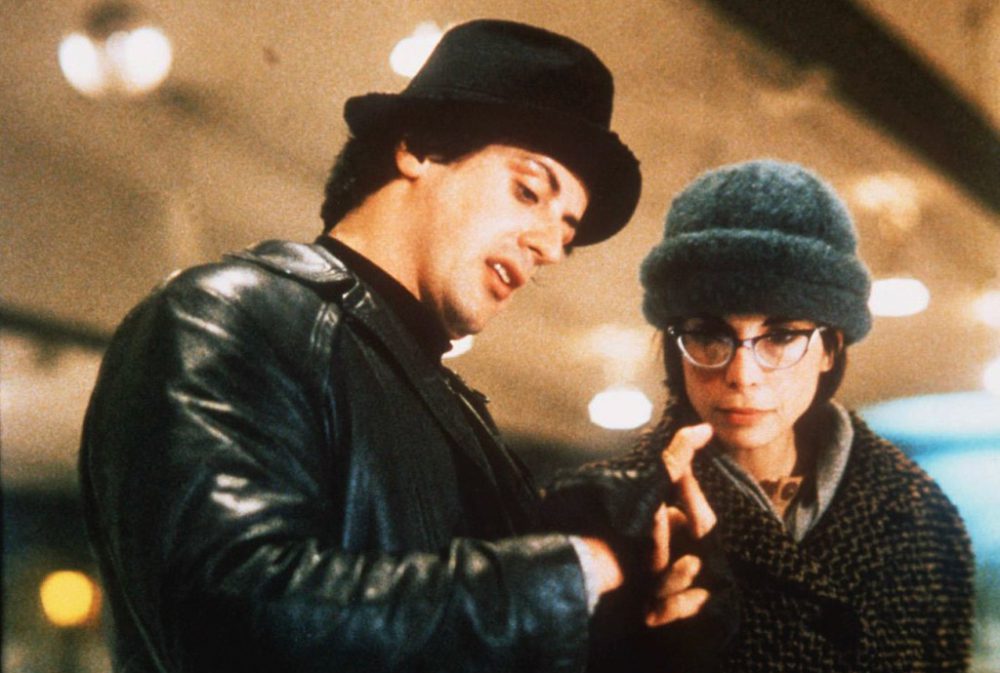
К середине 70-х Сталлоне обзавелся семьей и сыграл несколько незначительных ролей, но денег катастрофически не хватало — семья жила втроем с маленьким сыном в фургоне. Однажды актеру пришлось даже сняться в порно-фильме для поддержания «штанов». Помимо редких актерских ролей Слай подрабатывал швейцаром, вышибалой и уборщиком клеток в зоопарке — именно эти эпизоды его биографии частично легли в основу «Рокки». Переломным для актера оказался 1976 год, когда ему в голову приходит сюжет, на основе которого пишется сценарий фильма.
Личный пёс Сталлоне, Буль мастифф, снялся в «Рокки»
Пазл в жизни Сталлоне, наконец, начинает складываться в единую картинку — спустя какое-то время он находит студию, согласившуюся выкупить сценарий. Ему предлагают баснословные 250 000 долларов, однако Сталлоне предложил заплатить минимальные 20 тысяч, в обмен на исполнение главной роли в фильме. Нескладному с эстетической точки зрения актеру пришлось изрядно постараться, чтобы убедить режиссера Джона Эвилдсена в своей актерской состоятельности. Расчет Сталлоне сработал безукоризненно. Фильм «Рокки» вскоре после выхода (был снят всего за 28 дней) стал культовым, получив три «Оскара» и «Золотой глобус». А Сталлоне в очередной раз удалось доказать всем, что трудом и упорством можно достичь любой вершины, лишь веря в себя.
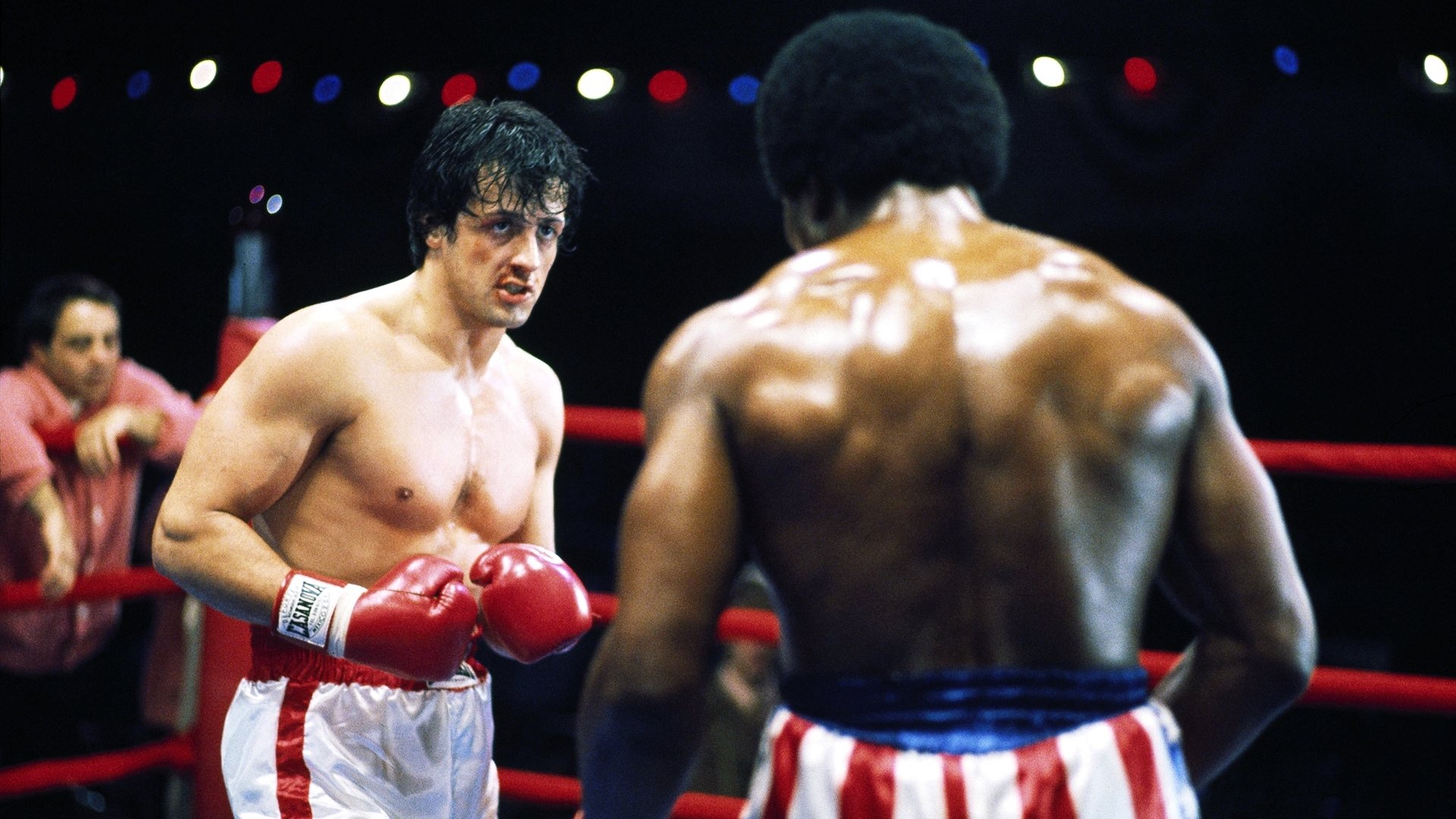
Свою правоту Сталлоне приходилось отстаивать не только в жизни, но и на съемочной площадке. Эпизод, где Рокки сомневается в своих силах и признается в этом своей девушке Эдриан накануне боя с «Аполло», продюсеры категорически не хотели снимать. Но после непродолжительных споров Сталлоне позволили сделать всего один дубль, а он так переволновался перед съемкой, что в итоге выпил лишнего.
Сталлоне написал сценарий за 3 дня
Своим упорством актер удивлял многих. К примеру, при подготовке к съемкам второй части «Рокки» он воспользовался услугами Франко Коломбо. Легендарный бодибилдер признавался, что взял с него кучу денег за тренинг, но при этом был поражен степенью фанатизма и самоотверженности Сталлоне. Стойкость и несгибаемость — эти черты характера не раз помогли ему в дальнейшей актерской карьере, а были у него и откровенные провалы (так, фильм «Рембо 2″ удостоили унизительной премии «Малина года» за худший сценарий и роль).
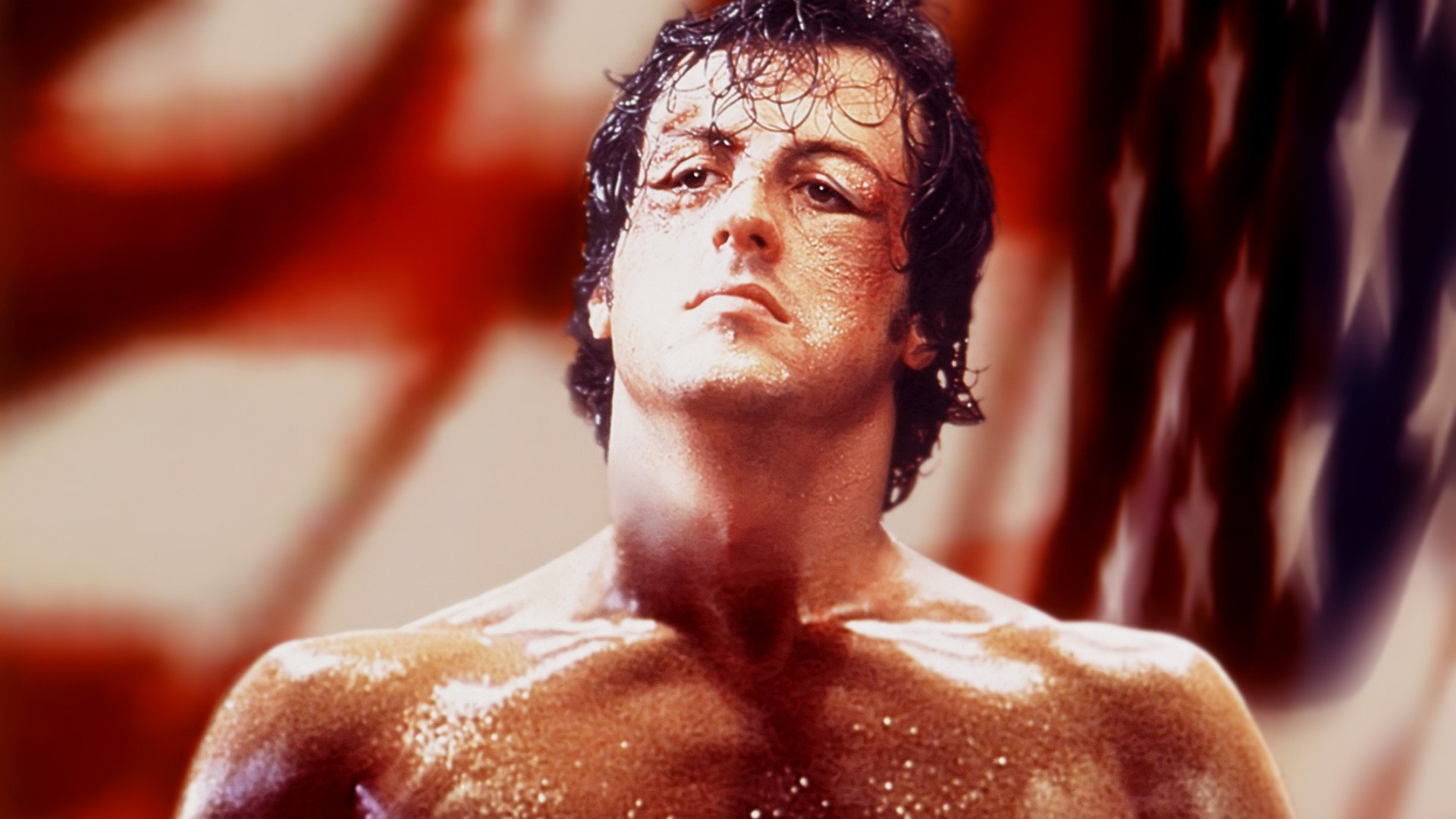
Можно сколько угодно подшучивать над мимикой Сталлоне и его актерским мастерством в целом (мемов и карикатур со Сталлоне не счесть), но стоит воздать должное этому человеку. Хотя бы за то, что он пример SelfMadeMan — человека, который сделал себя сам, не обращая внимания на критику и неверие окружающих — он и есть живое воплощение своего киногероя. Чемпион мира по боксу Винни Пазиенца говорил, что именно фильм «Рокки» воодушевил его стать второй раз чемпионом мира после того, как он сломал шею. Тысячи людей, выбегая на пробежку с утра, включают в плеерах знаменитую Gonna Fly Now и бегут к своей мечте, отпуская груз мыслей и любые невзгоды.
Цитаты из фильма:
«Пока гонг не прозвенел, бой продолжается. Лично вы слышали гонг? Лично я, нет, продолжаем»
«Я ничего не добился из-за него, из-за неё, из-за кого-то!» Так делают трусы! А ты не трус! Быть этого не может!»
«Ни ты, ни я, никто на свете не бьет так сильно, как жизнь!»
Фрагмент фильма:
Как снимали фильм «Рокки»
Первый «Рокки» появился в нужное время в нужном месте, и в этом главный секрет его оглушительного успеха. К 1976 году простой американский зритель изрядно подустал от критического реализма Нового Голливуда и хотел вместо очередной ленты, вскрывающей общественные нарывы, увидеть на экране олдскульную сказку о стране безграничных возможностей и равноправия, где каждый трудяга из низов может рассчитывать на мгновение триумфа.
Сильвестр Сталлоне, который в середине 70-х сам находился в полушаге от утраты веры в мечту и упорство, как никто другой чувствовал, что такая история США просто необходима, да еще и в юбилейный год двухсотлетия со дня подписания Декларации независимости.
Драматургия: Американская мечта с неожиданным финалом
Стойкость Уэпнера поразила закаленного чередой личных и карьерных неудач Сталлоне, и он сделал боксера одним из прототипов своего Рокки, а парафраз памятного поединка — кульминацией сценария, основная часть которого, по сути, является подготовкой к ключевому эпизоду. Финальный бой никому не известного Итальянского жеребца из Филадельфии с чемпионом мира Аполло Кридом Слай композиционно зарифмовал со вступительной сценой фильма, в которой Бальбоа побеждает слабого противника.
Кастинг: итальянцы вместо ирландцев, новичок вместо боксера-профи и все же Сталлоне
Загвоздка заключалась в том, что кинокомпания United Artists, финансировавшая проекты продюсерского тандема, настаивала на звезде рангом повыше. Например, студийных воротил устроил бы Роберт Редфорд, Райан О’Нил, Джеймс Каан или, на худой конец, «тот парень из «Лордов Флэтбуша»», но только не Сталлоне. Однако Слай был «по-рокковому» непреклонен и угрожал продюсерам закопать свой сценарий в саду, даже несмотря на отступные в 350 тысяч долларов, которые студия предлагала ему за согласие отдать роль другому актеру.
Данным требованиям идеально соответствовала сестра Фрэнсиса Форда Копполы Талия Шайр (Конни в «Крестном отце»), тем более что идею сделать дружественную Бальбоа семью ирландской из-за скромного бюджета пришлось отмести и заменить их итальянцами. Поэтому брата Эдриан Поля Пеннино сыграл Берт Янг.
Места съемок
Визуальное решение: стедикам, пластический грим, символизм и мизанабим
Саундтрек: Билл Конти и Фрэнк Сталлоне
Мотивирующий эффект «Рокки», покоривший не одно поколение кинозрителей, отчасти заслуга основной музыкальной темы фильма, композиции Gonna Fly Now, написанной Биллом Конти. Остальной инструментальный саундтрек — также его рук дело.
Смотрите также:
13 сцен, съемки в которых закончились для актеров трагично,
За кадром известных триллеров и фильмов ужасов,
22 закадровых фото известных фильмов, которые показывают, как снимается кино
А вы знали, что у нас есть Telegram и Instagram?
Подписывайтесь, если вы ценитель красивых фото и интересных историй!
Который сделал Сталлоне звездой.
На днях в нашем инстаграме прошло голосование на лучший спортивный фильм всех времен. При всем уважении к «Легенде №17» и «Чуду на льду» «Движению вверх», победитель был известен с самого начала. Все-таки остальные фильмы соревнуются в «спортивной» категории, а «Рокки» – один из лучших фильмов XX века.
«Рокки» – кино, которое обросло легендами.
В 1975 году Сильвестру Сталлоне исполнилось 29 лет. Нормальных ролей Слаю тогда не предлагали (он даже успел сняться в порнофильме), в банке осталось всего 106 долларов, а жена Саша была беременна. Дошло даже до того, что актеру пришлось отдать любимого пса Баткиса в другую семью – он не мог его прокормить. Сталлоне решил, что раз ему не дают нормальную роль, то он напишет ее сам.
Повезло: в кинотеатре Слай попал на показ боя между Мохаммедом Али и малоизвестным боксером Чаком Уэпнером. В 9-м раунде Чак отправил Али в нокдаун – это уже была сенсация, ведь ставки на победу Уэпнера перед боем были 40 к 1. Али все равно поднялся и в 15-м раунде победил техническим нокаутом, но история малоизвестного бойца, давшего бой лучшему боксеру современности, вдохновила Сталлоне.
Герой фильма «Рокки» реально существовал. История Чака Уэпнера
Слай на 3,5 дня заперся в комнате без окон, курил дешевые сигареты и написал черновую версию сценария, из которой потом вывел еще три вариации. Позже он рассказывал, что изначальные версии были гораздо более мрачными – Рокки могли убить в уличной драке или он мог сдать бой и на полученные деньги вместе с Эдриан открыть зоомагазин.
Сценарий был готов и отправлен продюсерам. Идея фильма о боксерах им очень понравилась, а когда им показали фотографию Сталлоне, они уже были готовы предложить ему главную роль. Смущало только то, что «Итальянского жеребца» будет играть голубоглазый блондин. Оказалось, что продюсерам показали фото Перри Кинга – партнера Слая по фильму «Лорды Флэтбуша». Снимать фильм со Сталлоне в главной роли продюсеры не захотели.
Перри Кинг – крайний справа
Сценарий хотели купить за 150 тысяч и пригласить Джеймса Каана, Берта Рейнолдса, Роберта Редфорда или Райана О’Нила. Сталлоне был непреклонен – или он, или никто. Жене он даже сказал: «Лучше я закопаю сценарий в саду, и пусть гусеницы играют Рокки».
Снимать кино с ноунеймом в главной роли согласились, только уменьшив бюджет вдвое. В итоге за сценарий заплатили 20 тысяч, а режиссером поставили Джона Эвилдсена – мастера поднимать малобюджетные фильмы. Слаю выписали минимальную недельную зарплату в 350 долларов. Можно было готовиться к роли.
Получив первый гонорар, Сталлоне отправился к семье, которой отдал бульмастифа Баткиса, и уговорил отдать его назад. В итоге пес сыграл в фильме и даже попал в титры.
Слай понимал, что от «Рокки» зависит вся его карьера. На протяжении пяти месяцев он тренировался каждый день. Когда Сталлоне впервые пришел на съемочную площадку, его спросили, готов ли он: «Я – нет, но Рокки готов».
На съемках было много травм. Костяшки Сталлоне до сих пор плоские из-за боксирования с ледяным куском мяса, а на съемку одной из тренировок главный герой пришел с температурой – за день до этого снимали сцену поцелуя с Талией Шайр. У актрисы был грипп, и Сильвестр заразился.
Фильм был снят всего за 28 дней в режиме строжайшей экономии. Даже сцену свидания на катке решили по сценарию провести на закрытой площадке, просто чтобы не платить массовке. Изначально Рокки должен был вообще позвать Эдриан в ресторан, но режиссер решил добавить сцене движения. Сталлоне не умел кататься на коньках, поэтому просто бегал рядом с партнершей.
Дольше всего снимали финальный поединок Рокки и Аполло – четыре недели. После неудачного первого дня съемок боя Эвилдсен расписал каждый удар и каждое движение актеров. Получилось 14 страниц сценария со словами «хук правой» и «хук левой». Сталлоне и Карл Уэзерс (сыгравший Крида) разучивали все как танец, а потом еще и доснимали некоторые сцены после просмотра ошибок на повторе.
Во время боя Сталлоне получил трещину в ребре, а Уэзерс – перелом носа. В фильме все наоборот: нос сломали как раз Рокки.
Кстати, сцена поединка принесла фильму «Оскар» за лучший монтаж. Ее снимали в обратном порядке с 15-го раунда, когда актеры были в полном гриме. С каждым раундом с актеров снимали накладные синяки, разбитые носы и разбухшие брови.
Кстати, на съемки матча позвали много звездных боксеров, но пришел только Джо Фрейзер. Ничего удивительного – он живет в Филадельфии, да и, по словам Сталлоне, персонаж Рокки отчасти списан с него.
Слай и Эвилдсен воевали со студией даже по поводу места съемок – несмотря на экономию, фильм выбивался из бюджета и снимать отдельную сцену пробежки в Филадельфии не хотели. Режиссер и автор сценария убедили продюсеров, что в фильме про итальянского боксера из Филадельфии не может не быть пейзажей города.
Знаменитую пробежку снимали чуть ли не в последний день – без вагончиков, без еды и даже без туалетов для команды. Зато была техническая новинка Steadicam – переносная камера, гасящая любую тряску. Всего за год до этого оператор Гаррет Браун разработал эту систему, и «Рокки» стал третьим фильмом, в съемках которого она поучаствовала.
Джон Эвилдсен увидел рекламное видео Брауна, снятое с помощью Steadicam: жена оператора взбегает по ступенькам Музея Искусств в Филадельфии. Режиссер позвал Гаррета снять такую же сцену и для «Рокки». Сейчас Steadicam используется при съемках большинства кинолент и спортивных событий.
Из миллионного бюджета «Рокки» все-таки выбился. Продюсерам пришлось даже заложить собственные дома, чтобы достать недостающие 100 тысяч долларов. Но все окупилось. В кинотеатрах «Рокки» собрал 225 млн долларов – в пересчете на нынешние деньги это все 500 млн. Бонусом шли «Оскары» для лучшего режиссера, за лучший монтаж и лучшую картину (в соперниках были «Таксист» с Де Ниро и «Вся президентская рать» с Хоффманом и Редфордом).
Продолжения «Рокки» снимал уже сам Сталлоне, но они не были такими успешными. Зато в третьей части появилась легендарная «Eye Of The Tiger» группы Survivor, а в четвертой – Дольф Лундгрен в роли Ивана Драго (фильм получил три «золотых малины», но собрал в прокате больше всех остальных частей).
В январе 2019 года выйдет «Крид II» – последний фильм, в котором появится Рокки Бальбоа. Хотя Дольф Лундгрен считает, что Слай не готов отпустить своего любимого персонажа. Да и Джон Эвилдсен как-то сказал, что Рокки как Бэтмен или Джеймс Бонд – такие герои не умирают.
Просто пересмотрите сцену той самой пробежки Рокки и убедитесь, насколько это великий фильм (и великая музыка Билла Конти).
imdb.com/imdb (1,2), Metro-Goldwyn-Mayer Studios Inc. (3,4), Film and Digital Times

